Golden Earring Forever!
| Golden Earring: |
| Rinus Gerritsen |
| Barry Hay |
| George Kooymans |
| Cesar Zuiderwijk |
The continuing story of
Golden Earring
The Seventies
Several picture links missing - will be updated soon! Sorry for the inconvenience! Casper Roos

1970 - End of 1969 and early 1970 the band toured the United States for three months again, this time with drummer Sieb Warner but soon the feeling grew Warner had to be replaced. Sieb Warner was a sensitive and introvert person and difficult to work with. He didn't fit the band profile the way especially George wanted it to be. In a form of cooperation like The Golden Earring had at that time; in which they spent months sharing hotel rooms and in which the musical discipline takes it's toll, this led to problems. During their second tour of the States things went wrong between the original band members and Sieb Warner, so the band started to look for a replacement. Unlike the other band members, this was Sieb Warner's first visit to the USA. His fascination with the country led to numerous problems. He was late for rehearsals and disappeared frequently without word of his whereabouts. His on-stage performance also left a lot to be desired. Upon returning to Holland, the group decided there was no choice but to let its new drummer go. Even before the bad road experience in the States, The Golden Earring just didn't feel comfortable with Warner's rhythm work. As talented as Sieb was, he and Rinus failed to gel as a rhythm section. But also the different kind of individuals and Warner already being a father while on tour in The States made the replacing inevitable. At the same time the band shortened their name again to Golden Earring. (Since the single "Back Home").
From this second USA tour 8mm movies survived, made by drummer Sieb Warner himself! The band got a small show review in the Fusion Magazine of February 06, 1970: "The Golden Earring, one of Holland's top rockgroups currently on a three month tour of the US, played at the Boston Tea Party on January 6th. Their musicianship was on a high level and their performance was spectacular. Their set climaxed with a long and frenzied performance of "Eight Miles High" which included one of the most imaginative bass guitar solos ever heard."
The band did also 4 shows supporting Delaney and Bonnie and Friends ("One" of the friends was Eric Clapton) on February 19, 20, 21 and 22 1970 at the Fillmore West in San Francisco.
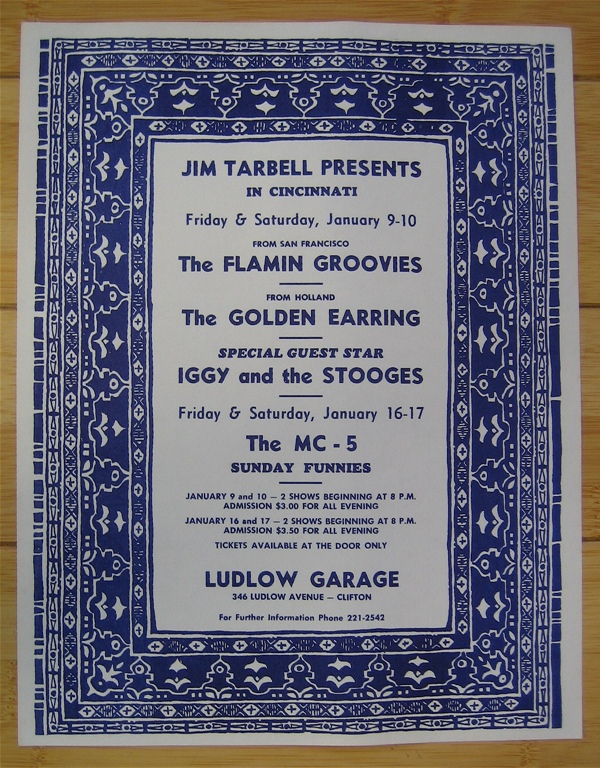
The USA Cashbox magazine dated February 28 1970 had a small announcement about The Fillmore West shows. "It's Atlantic week in San Francisco. Delaney & Bonnie & Friends featuring Eric Clapton (imagine what would happen if they started billing all the friends), along with the New York Rock & Roll Ensemble and Golden Earrings, are all at The Fillmore West, while Sonny & Cher open a stand at the Fairmont Hotel. The Earrings, when last we heard, were booked for a Whiskey date this week."
In an Magazine ad there was promotion for the Eight Miles High album which was released on the Atlantic label (Atlantic Records SD-8244, which also excists as a white label promo, both versions released in 1970). A quote from the ad: "Golden Earring manages to come up with the kind of flaming excitement that gets standing ovations (as the group did in a recent Fillmore East appearance...) The key to Golden Earring's success is their 18 minutes version of The Byrds Eight Miles High. It's 18 minutes on the record anyway. On stage it drives and floats, reaches half a dozen climaxes, innumerable solos and holds together with the rocking, ringing refrain... Golden Earring, a superb Atlantic underground rockgroup... from Holland." The text from the ad was partially taken from the January 10 1970 Record World Magazine article "Getting It Together". The ad also mentioned several 1970 USA tour dates.
The USA Billboard magazine dated March 07 1970 mentioned the "U.S. debut tour" was extended by a month and finally lasted about three months. Actually this was Golden Earring's second USA tour. "Golden Earring U.S. Debut Tour is extended. New York - The current American debut tour of the Golden Earring, Dutch group on Atlantic Records, has been extended by a month. The group is managed in the USA by Zach Glickman's New Dawn Artists Management Inc. under an arrangement with Red Bullet Productions in Holland. The group has upcoming dates at Fillmore West, San Francisco, and the Whiskey A Go Go, Los Angeles. Atlantic will stage promotional receptions for the group at the San Francisco and Los Angeles dates. The tour was booked by Zell Enterprises Agency in California."
On March 19, 1970 the band returned at national airport Schiphol from their second USA tour.
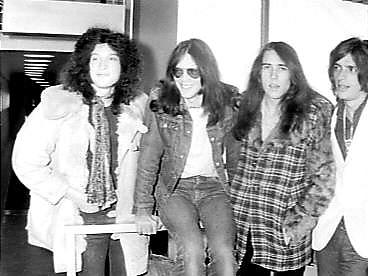
Somewhat earlier on January 31 1970 the single Fat Jack by The Hearts Of Soul entered the Dutch Top 40 chart at #32. This song was written by George Kooymans. The song was Alarmschijf on pirate station Radio Veronica. Another single track written by George Kooymans was the song Seasons by Earth And Fire. While George Kooymans and his band were on the second USA tour the single entered the Dutch Hitparade and became a number 2 hit for Earth And Fire in January 1970 due to a lot of "airplay" on the offshore pirate station Radio Veronica. (Seasons\Hazy Paradise catalogue info: Polydor S 1335)
After their return Golden Earring performed in Den Haag on April 04 1970 at the nederlands Congresgebouw. This was a night show starting at 00.00 hr.
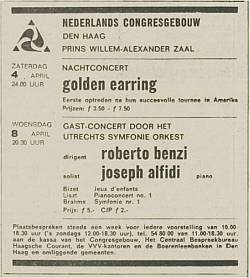
Golden Earring performed on April 27 1970 at the JKW youth centre in Wateringen. Below is a scan of the original ticket as sent by fan Ria Brekelmans. Entry fee was 5 guilders.
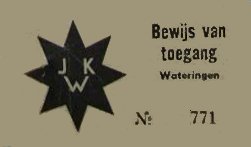
Golden Earring performed at the Pinkpop Festival in Geleen (Holland) on May 18 1970. Entrance presales fee was only 2,50 guilders and when the original ordered sound equipment wasn't suitable for a festival Golden Earring provided it's own equipment and made sure the festival could go on as all bands use their sound system ! During Golden Earrings show George was electrocuted but despite could play on. Out of anger he kicked a microphone stand. This can be seen on the DVD Pinkpop the vintage years which shows views from this concert.

It all started in 1969 when a few social workers organised a small music festival in the town of Geleen, in the south of the Netherlands. It was ment to be a once-only event, where Dutch music lovers could gather and create a laid-back atmosphere likewise the succesful Montery and Woodstock festivals before. Nobody expected that 10,000 people showed up and somehow the headliner, which was Holland’s internationally most succesful band, the Golden Earring, were so kind to borrow their professional sound equipment and PA system to the festival. They saved the first edition as the few installed speakers (which were used by sports commentators during bicycle races!) could not provide a decent sound. The day after the festival the group of organising social workers were amazed by the profit that was left after paying all the expenses. They decided to invest the money and started working to realise Pinkpop 1971.
Finally it became inevitable: Fred Haayen told Sieb Warner he was fired and the band had to look for another drummer. Warner himself did feel the same about his position in the band as the others: he felt not in place and different to the other members. But the way he was told to leave the band made him sad. He had expected the bandmembers themselves would have told him about their decision and not the manager instead. Adjusting to others he didn't want to do any longer and went out of the business. The last show with Sieb Warner was at De Vliegermolen in Voorburg. Sieb still has some instruments like conga's, drums and a sitar but never played in a band again.
In the Summer of 1970 drummer Cesar Zuiderwijk took the place of Sieb Warner and performed for the first time at the Aken festival in Germany on July 10, 1970. The classical band line-up was complete now and remained intact for many, many years. The track ‘Back Home’ was released on single in July 1970, entered the hitparade on July 18, 1970 and became their second number one hit for the band in Holland with over 100.000 sold copies. Golden Earring had already scored 13 Top 40 hits in the Sixties (for a large part, until 1969, under the name the Golden Earrings), including a #1 hit for Dong-Di-ki-Di-gi-Dong, when this single, Back Home, became their first hit in the Seventies. Appropriately, it shot straight to #1. Compared to most of their previous work, this song, and the accompanying Golden Earring album, were much more hard rock oriented, with even some prog tendencies (the flute play, reminiscent of Jethro Tull and Focus, for instance). Of course, the later Radar Love tended to overshadow all their earlier work, but this one is well worth listening.
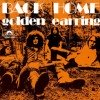
Back Home was written after the first USA adventures of the band. It told about how the Earring felt when being away in the States and how good it is "to be back home." Although they have been from "border to border" in the States, the band still appreciates their home country! The Earrings and especially George always felt kind of homesick while on the road in foreign countries and wanted to get back after a few weeks. This story was told many times and was one of the main reasons why Golden Earring never got it's final breakthrough abroad although scoring several huge hits in the future... In Germany they reached with Back Home a first high position in the charts too. For Back Home a recording for TV-program Toppop (AVRO), from September 29, 1970 was used which was shot with their new drummer Cesar Zuiderwijk in the dunes of The Hague, right behind the legendary Marathon Club where each self-respecting beat group of The Hague did perform.
From 1968 untill 1970 Cesar was a member of Livin' Blues. One of the first recordings with Cesar was their single Murphy McCoy\Sister Kate. Murphy McCoy was written by George Kooymans and there even excists a demo version of the track with George on lead vocals. In 1969 the album "Hell's session" was released with Cesar on drums. Later on during the recordings of the album "Wang Dang Doodle" Cesar Zuiderwijk quit Livin' Blues. The credits for Wang Dang Doodle didn't mention Cesar, but actually he was the drummer on the tracks I came home at night and Go-go train. Cesar started out in the band The Ladybirds. In 2005 a new book was released called Den Haag Popstad. At the Den Haag Popstad site you can order the book for 22,50 euro. A quote from the book: "And who knows Cesar Zuiderwijks first band was called The Ladybirds was and that after he left his succesor in this ladyband was Marja van der Toorn, who later made name as Polly and finally as Sugar Lee Hooper".
With Cesar Zuiderwijk joining the band, Golden Earring did find a perfect social and musical balance and they started to work straight away in Hilversum on their new lp. This lp was recorded again at the Phonogram studio (Hilversum, Holland) in July 1970 with Albert Kos being the recording engineer. They released the self titled album Golden Earring on September 05, 1970. (This album is sometimes referred to and better known as Wall Of Dolls due to the cover picture which was photographed at the Amsterdam Waterlooplein fleamarket). With this selftitled album the Dutch quartet made their first real rock album. The record contained several bombastic, almost hardrock influenced songs, and the representative Back Home became a number-1 hit again. On this album you can hear that after their American adventures, they began to play in a rougher style. This resulted in Germany opening up as a possible market; they really raised the roof at their concerts there. Golden Earring (the album) became the first Golden record in their career. The album stayed in the Dutch album charts for 31 weeks (of which six weeks on number 1!) and the album became gold awarded on November 19, 1970 for over 35.000 copies sold. Another milestone again! The album Golden Earring was also released in the USA on the Dwarf label (label number PDLP-2000) which was distributed by Perception records, which I believe is from Holland. The album has a gate-fold cover and the record itself is also known to be released as a promotional copy, not for resale. This usually means the earliest pressing, for radio station distribution. You can identify a promotional copy due to the text on the album label, right beside the lp vinyle hole. The normal release doesn't have this text.

Golden Earring was the last Golden Earring album Cees Schrama was to be heard on. From that album on we didn't see any arrangements by Mijts anymore. Cees played piano and mellotron on the first album track Yellow And Blue. On the The Wall Of Dolls track Cees was heard with different kinds of keyboards. He also played keyboards and tambourine on ‘Back Home’ and mellotron on ‘See See’.
Late that summer, Golden Earring headed to Germany to play the Pop & Beat Koncert Festival in Nordseehalle, Helgoland on August 15, 1970. Pan, Slade, and Made In Sweden were among many other groups who also played at the festival. Radio Nordring sent in excerpts from the festival the same day on the radio's P1 as Helgoland-International sommerradio. From Golden Earring several songs are known to excist in the collectors circuit.
On August 21, 1970 the release of the new self titled Golden Earring album was a fact (also known as Wall Of Dolls). The album soon went gold for the sale exceeding 25.000 copies on September 24, 1970. This was Golden Earring's first golden record in The Netherlands.
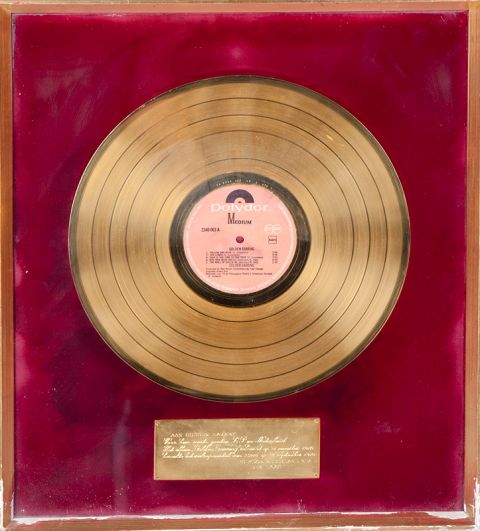
On October 16, 1970 Golden Earring performed with the Kinks again at the Festhalle in Levern, Germany. More German shows were done as they also did a gig at a Bremen festival which took place from 31.10 - 1.11.1970 together with Free and Spooky Tooth.
The Golden Earring recorded their fabulous psych-record Eight Miles High in 1969. This record was also released in Japan in November 1970, as both a promotion record (white label, no insert, no OBI) and a red label stock copy (no insert, possibly an OBI, though never seen). This album is seldom seen, and was pressed in very limited quantities. Therefore copies of these albums are rare and collectors items. The sleeve is non-laminated and textured. On the front there is a picture of Golden Earring which dated from 1969, with Jaap Eggermont as a drummer (Which is not correct, as on this album Sieb Warner plays the drums). On the back the lyrics have been printed and some Japanese text, like songtitles and the list price (yen 2,000). The record was released on the Polydor label (Polydor MP2111) and was manufactured by Nippon Grammophon CO., LTD, Japan in November 1970.
The Back Home single was also released in Switserland and entered the Swiss hitcharts on November 03, 1970. It ended up at highest position #6 and was in the charts for 9 weeks.
On November 19, 1970 Golden Earring was presented a golden record for their gold album "Golden Earring" with the hit Back Home. The presentation was at the Scaramouche discotheque in Hilversum. Around this time rumours were there the band would go to the USA again around January\February 1971 for their third USA tour. These plans were made by Freddy Haayen but never were carried out. However several publications in magazines and interviews reported about this plan. The band had to wait untill 1974 to go back for another USA tour again.
On December 12, 1970 the band performed at the Amsterdam Concertgebouw. This show was also to celebrate their album Golden Earring became gold. Golden Earring performed together with the English band Collosseum in front of 2000 visitors. A review from this show was published in the Volkskrant newspaper December 14, 1970 titled Golden Earring zweept zaal op. Prior to the concert was announced recordings would be made for a live album. However the Veronica Magazine dated December 25, 1971 mentioned record company Polydor had announced that a new album would be released around February- March 1972 with on one side live recordings. History learned however this new album only had studio tracks on it and the plans for a live album were postponed. The first live album released is called Live (1977).
For Golden Earring the Seventies marked a period of growth. Unlike many other Dutch groups the band stayed in touch with the market and was surrounded by professional advisors, like producer and record label manager Fred Haayen from Polydor. The Voorburgse formation Earth & Fire scored their first big hit with ‘Seasons’, written by George Kooymans. Female singer Patricia Paay recorded a single called Tell Me You're Never Gonna Leave Me. (Imperial sc 00624254) This song is written by George Kooymans and the b-side of the single is One Huge Road (also written by George Kooymans), which Golden Earring recorded themselve in 1969 for their album Eight Miles High. The single was also released in Spain with a different cover (Dutch records label, 1971 according to Patricia Paay fansite).
Rinus Gerritsen participated on the Q65 Afghanistan album which was released in 1970. This album was released on cd in 1992.
In 1970 a Dong-Dong-Di-Ki-Di-Gi-Dong cover was released by:
1970 Germany?: Super Circus - Dong-Dong-Di-Ki-Di-Gi-Dong (7")
In 1970 a One Huge Road cover was released by:
1970 Netherlands: Patrica Paay - Tell Me You're Never Gonna Leave Me\One Huge Road (7")
1970 Spain: Patrica Paay - One Huge Road\Tell Me You're Never Gonna Leave Me (7") Might be 1971)
1971 - On Sunday January 03, 1971 Golden Earring performed probably at the Berchmans at Maastricht. The poster was auctioned in 2008 at Van Sabben Auctioneers with this info but without the year. My research points out January 03 is on a Sunday in 1971.
The band played this year mainly in Germany if performing at all. With the huge 1970 hit Back Home, which stood for 20 weeks in the national charts, there was the need for another hitsong. We will see this phenomenon repeatedly coming back in the Golden Earring story, but the commercial success of one song resulted in an attempt to write a similar song, sometimes under pressure from others. It didn’t always had the desired result, but often it resulted in a good, or at least memorable, song. In February 1971 they released Holy Holy Life as a single (Polydor 2001 135), which entered the charts on February 06, 1971 at position 14 and reached the top 5 again. B-side was the track Jessica. Both Holy Holy Life and Jessica are non-album tracks. Holy Holy Life was also released on single in Japan. The Japanese single has a different cover layout and are hard to find. Also on February 06, 1971 the band was presented an Edison award out of the hands from Willem Duys live on Dutch television. They performed Holy Holy Life as well.
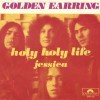
From 1970 on the band regularly toured through Germany and so they were often seen in various Pop TV-shows. For Holy Holy Life they performed in the Hits A Go Go TV-program (NCR, German broadcast corporation) on May 26, 1971.
The band gained more and more recognition and in May 1971 in Japan an unusual sampler album was released. It's an album in the "Battle Of The Bands series". On May 15, 1971 Nippon Grammophon began to release a "Rock 'n Roll battle series" to run through August 1971. There were 10 double album releases in the series, each packaged in a round metallic can. Free posters were presented to buyers of each set, and buyers of three or more sets also received a free, imported and unreleased rock LP from DGG (Deutsche Grammophon Gesellschaft). The sets were priced at 3000 Yen (about 8,33 US$ at the time) and included besides Shocking Blue versus Golden Earring, The Who versus Jimi Hendrix, Deep Purple versus Jimi Hendrix, Cream versus Derek and The Dominoes, Eric Burdon versus Blues Project, Cream versus John Mayall, Cream versus Ginger Baker's Airforce, Bee Gees versus Blind Faith and Eric Clpaton, The Who versus Jimi Hendrix "Live" and Eric Burdon & Animals versus Mothers of Invention.

Golden Earring's single Back Home was released in Italy as well in 1971 on Polydor 2001 073, in an unique picture sleeve. It was in fact a remake of the album cover of the Wall of Dolls-album, which was released in 1970. The single didn't reach any charts in Italy and is hard to find nowadays.
Meanwhile both George Kooymans and Barry Hay were busy recording their first solo albums.
On June 08, 1971 the Avro broadcasting company broadcasted a tv special about Golden Earring. This special was recorded on April 16, 1971 and should have been broadcasted on May 21, 1971 but due to an unexpected extra Europa Cup football final between Real Madrid and FC Chelsea the special was postponed to June 08, 1971. The final on May 19, 1971 ended equal so the return game was suddenly planned on May 21, 1971 and replaced the planned Golden Earring special.
The Dutch magazine Muziek Expres July 1971 issue included a Golden Earring poster.
In the Summer of 1971 they released the Seven Tears album, recorded in Hilversum again. They started to experiment, ended up on a psychedelic trip and used the nowadays legendary ARP synthesizer for the first time. Their record company wanted to release She Flies On Strange Wings on single. The duration of that song is 7 minutes and 22 seconds and editing it into a shorter song was out of the question for the band. They solved the problem by dividing the song into two parts. Part 1 ended just before the quiet piece in the middle of the albumversion of the song, so that part 2 would fit as a b-side on a single! The long version can be found on the album Together. The single She Flies On Strange Wings was released in October 1971 and it's highest chart position was 4 (11 weeks in the charts). The band filmed a long version (but play backed) clip for this single on the roof of Amsterdam Hilton Hotel. It was shown in the Pop van Jan de With tv program (AVRO) on September 08, 1971.
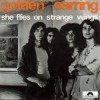

On August 08, 1971 Golden Earring performed at the Festival Pop during the Fetes de la Djote at Jemelle (Belgium). The band performed as headliner at the festival. Amongst the other band were Soft Creation, Batman, Black Funeral. Michigan, Madscap, Happy Days, Doctor Down Company, Lager Blues Machine, Carriage Company, Jenghiz Khan and Genesis (which preceeded Golden Earring)

On August 10, 1971 Golden Earring recorded the videoclip for their single She Flies On Strange Wings at the roof of the Hilton Hotel in Amsterdam. The recordings were made by director Egbert van Hees for the new Pop van Jan de Witt tv show. The tv show was broadcasted by the AVRO from September 08, 1971 on between 19 and 20 hr.
The 1970 album "Golden Earring" was awarded with an Edison in 1971.
Around 1971/1972 Rinus Gerritsen moved to Voorburg where he bought a house. Views from this house can be seen on the cover of the Together album. Nowadays Rinus Gerritsen still lives in the same house which has been renovated by himself over the years and has a home studio in it.
According to an article in a Dutch 1971 music magazine over 25.000 copies of the album Seven Tears were sold during the first months after its release. Golden Earring planned to record a live album in November 1971 at Montreux which should be released in Spring 1972. History however learned this album was never recorded and it would last untill 1977 before the first live album was released called Golden Earring Live (2lp) mainly recorded at an UK concert. According to the same article Rinus Gerritsen was working on a solo album as well. This would last untill 1979 before it was ready and released. (Gerritsen en van Dijk album).
On December 25, 1971 the first solo single by George Kooymans called Lovin' And Hurtin' (Polydor 2050 156) entered the Dutch Top 40 hitchart at position #34. Lovin' and Hurtin' is a track from the Jojo solo album which was released November 05 1971 (Polydor 2925 004).
In 1971 Golden Earring members Barry Hay, Cesar Zuiderwijk and George Kooymans participated in the band-project named Holland and recorded the single Hans Brinker Symphony/Silverfleet (Polydor 2050 -071). The band Holland (not to be confused with two later bands or projects of the same name) was a once-off studio cooperation between a list of Dutch musicians who either were already famous (Golden Earring, Earth and Fire, Patricia Paay) or would become famous a few years later (Yvonne Keeley, Anita Meyer). The theme of their only single release from 1971 was as Dutch as you can imagine: Hans Brinker is of course the legendary Dutch boy who put his finger in a dyke to stop the flood. The song itself is based on an old Dutch folk song, which gets a mainly instrumental rock treatment - vocals are used but wordless. A strange song. Dutch Top 40: top position 7, duration 6 weeks.
Sometime later Rinus Gerritsen was involved in the Musicians Union Band project. They released a single called Bad Boy/Carolina Belle (Polydor 2050 102) and the lp Musicians Union band (Polydor 2675 009) which contains a song written by Rinus Gerritsen called Sugar Lip Sal.

1972 - Golden Earring did many gigs this year, also abroad, several of these foreign show were done as special guest for the The Who 1972 European tour.
The January 1972 edition of the Dutch MuziekParade magazine #178 had George Kooymans on the cover.
On April 01, 1972 the Avro broadcasting company broadcasted part of the on June 08 1971 shown tv special again. On April 21 1972 Golden Earring performed at Avro's Toppop according to ANP photo. They published a promotional photo from the band on which Rinus Gerritsen can be seen with his double neck Dan electro bass guitar. This bass guitar was stolen a few years later during an American tour!
Buddy Joe was their new single and taken from the Together album. Buddy Joe was released May 1972 and highest chart position was 4 (9 weeks in the charts). In a time of album orientated singles, this was once again a song with definite hit potential. Golden Earring developed an own authentic and energetic rocksound. With this sound they score hit after hit in The Netherlands but also in other countries like Germany and America (later on).
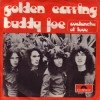
On May 20, 1972 Golden Earring performed at the Philipshalle in Dusseldorf (Germany) at the "Popnight" together with Excalibur, Journey, Steamhammer, Atomic Rooster, Hawkwind and Nazareth.
The June 1972 edition of the Dutch MuziekParade magazine #183 had Barry Hay on the cover.
Their new studio album Together was released on June 09, 1972. It was recorded in the first two weeks of March 1972 at the Island Studio's London, England. The working title for this album was "Cheese" but as the graphic designer of the cover couldn't make the deadline in time the title was changed at the last minute. The album title was appropriate as continuous rumours about a band split proved to be wrong.
Also on June 13, 1972 the band were presented two golden albums for Seven Tears and Eight Miles High out of the hands from Ajax defensive player Barry Hulshoff. At first world famous soccer player Johan Cruyff was asked to present the golden albums but as he asked a fee of 10.000 guilders for it he wasn't hired. So another but less famous and much less costing soccer player was present at the ceremony.
In the Seventies they signed internationally with the Track-label which gave them In Summer 1972 the band was given the chance to tour with The Who as support act for their 1972 European tour. Golden Earring was personally invited by The Who guitarist Pete Townshend and all four Golden Earring bandmembers had to cancel their already scheduled summer vacations. The band performed for this tour one concert in Holland on September 08 1972 at the Ahoy (Rotterdam). The setlist was Big Tree Blue Sea, Stand By Me and I'm Going To Send My Pigeons To The Sky/Eight Miles High (35-40 minute set). Some other concerts on this tour were in Frankfurt, Berlin, Munchen (during the Olympic Games!), Vienna, Lyon and Rome to name a few.The German paper Frankfurter Rundschau, dated August 14 1972 had a review from one of the support shows Golden Earring did for the Who on August 11 1972 at Frankfurt. This is the Golden Earring part of the review: "Golden Earring", sonst in etwas kleinerem Rahmen Hauptgruppe, diente nur zum Aufwärmen, schaffte es auch prächtig, wurde damit aber ein wenig "verheizt" - viel zu kurz war die Zeit, die den vier Holländern zu Verfügung stand, um ihren 40-Minuten-Titel I'm Gonna Send My Pigeons To The Sky" organisch vorzubereiten. George Kooymans beherrschte mit seiner Sologitarre die Halle. Am vorzeitigen Höhepunkt muβte das Ende kommen." In English this would be translated that Golden Earring only supposed to be a support act made quite an impression but as they were given not to much playing time the set couldn't come to a full extend. But George Kooymans and his solo guitar ruled the venue...

Later in August 1972 the Who visited Denmark again as part of their European tour. On this tour they played mostly sports arenas. This gave a lot of people the chance to see the Who (unlike during their opera tour), but of course the sound and intimacy suffered from the sports-arena-type-concert. KB-Hallen was on the other hand the same tennis arena the Who had played in '65, and at least on stage it was intimate enough. The Who had to crowd onto the stage with much bigger equipment than in '65, yet it seemed to be exact same stage as back then. Their two Copenhagen concerts were of course part of the Scandinavian leg of the tour. The concerts were both fine enough, even though the last one had to be postponed three days from the 22nd to the 25th. The concerts haven't really made history though, rather the hotel stay did. The extra KB Hallen concert was to be held August 22, 1972, but the Who had to move it to August 25, 1972, in order to get all equipment to Sweden in time. (Stockholm: August 23, 1972, Gothenburg: August 24, 1972) Keith Moon's birthday was on the August 23, 1972, and it seems that the Swedish hotels were lucky that Keith Moon didn't decide to celebrate his birthday until August 25 after their second KB Hallen gig. The "birthday party" at Sheraton hotel in Copenhagen evolved into one of the most "fantastic" (horrifying?) destruction orgies of all time. To cut a long story short. [It's all in the book "Moon the Loon" (or "Full Moon" in USA) by Dougal Butler]. The Moon party started with trying to stuff a water bed mattress into one of the hotel elevators, so it would fall out on anyone who'd open the elevator doors (preferably an American tourist). The mattress broke before they even got it out into the hallway, and the water flooded the floor. Moon convinced the hotel personnel that the room had been flooded on arrival, and they were given one of the suites instead. The party proceeded with, mainly Keith Moon, smashing the entire hotel room interior including the windows. Later the same year the Who was charged 14000$ (=105000 DKr), to cover the damages in hotel rooms on three floors!
On August 17, 1972 Golden Earring performed with The Who as their special guest during a concert in de Oude Rai in Amsterdam.
Stand By Me was released on September 11 1972 as another single and slipped in to keep things going. This version of the single was a re-recorded version as the initial first version was recorded at the Island Studio's but the band wasn't satisfied with the choir vocal part. Therefor the band decided to record it again at the Phonogram studio. This information can be found in an interview with Cesar Zuiderwijk gave for the Veronica 538 magazine (Issue 41, from October 07, 1972). On September 23, 1972 the Stand By Me single entered the Dutch national Top 40 hitlist at #23, finally reached highest position 10 and stayed 7 weeks in the charts. To promote this single the band came to the studio for the KRO TV-program Waauw!, hosted by DJ Theo Stokkink. They played a live version of All Day Watcher which was the singles b-side.
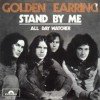
But the band came within a creative crisis, not unusual for a band that has been around for a while and was constantly on the road. Tiredness, lack of motivation, these are the less pleasant aspects in the career of a recording artists. A positive fact is, however, that this usually led Golden Earring to a new milestone in their career. In the period 1972 - 1973, they were constantly on the road, mainly in Germany. But an extensive tour of the whole of Europe, as the support act for The Who gave them a new impulse.
A rare bootleg recording from one of these gigs was preserved. Golden Earring's support show for the Who at the Vienna Stadthalle was audience recorded on September 02, 1972. Golden Earring performed 4 songs: 1. Intro, 2. Big Tree Blue Sea, 3. Stand By Me, 4. Bass Solo/I'm Going To Send My Pigeons To The Sky. The quality is fair but as said a rare recording as not many performances before this show were bootlegged. The bootleg is known as Golden Earring Vienna 1972.
During the many support act gigs for the European tour of the Who they already proved their high class and they continued to build up their success abroad. After Germany Britain became the next challenge; Golden Earring signed to the Who's Track label, which released Hearing Earring (Track 2406 109), a compilation from two Dutch albums in 1973 (Seven Tears 1971\Together 1972). The UK version has braille print on the cover. This release helped the group break through in England. This led to concerts in the United Kingdom as well (Spring 1973). The spirit was back!
Some background information on the co-operation with The Who and their Track label. The Track Record label was founded in 1966 by Chris Stamp and Kit Lambert. Christopher Sebastian ("Kit") Lambert is born May 11 1935, son of composer Constant Lambert. After working as a co-director with movies like The Guns Of Navarone and From Russia With Love Lambert became manager in 1964 d from a thus far unknown group, called The High Numbers. Soon afterwards the band name is changed into The Who. The in 1966 founded Track records label signs and releases albums for artists like Jimi Hendrix, The Crazy World Of Arthur Brown and Thunderclap Newman. In 1974 Kit Lambert and The Who part their ways after a business argument. Track Records then goes broke and former manager Kit Lambert seeks refuge in alcohol and drugs. On April 07 1981 Kit Lambert falls down the stairs of his mother's house in London. Soon afterwards this trauma he died at the age 0f 45 due to a cerebral bleeding.

Adjacent to George’s back garden in Blaricum was the Soundpush Studio. Here they all worked hard on the demos for a new album that was to be a new milestone for the band: Moontan.
Both George Kooymans and Barry Hay released their first solo albums with not to much commercial succes. They both released a single as well. (Lovin' And Hurtin' by George Kooymans and Did You Really Mean It by Barry Hay. George called his album ‘Jojo’ (Polydor 2925 004, released Autumn 1971)and Barry ‘Only Parrots, Frogs And Angels’ (Polydor 2925 006, released May 1972). Jojo is another (nick)name for George as he was named by friends that way. Of course these solo projects caused rumours the band would split soon. But this was denied by the bandmembers. George Kooymans told the songs he had written for his solo album were much more melodic than the ones he wrote before and therefor not suitable to be performed on stage. He wanted to use the songs anyway and decided to record them for a solo album of his own. Barry's album has a fine colourfull cover with stunning fantasy psych artwork over both panels and hand written lyrics printed on it. The front of Barry Hay's album has a button in the cover on the upper left side and perforated surrounding to hold it.
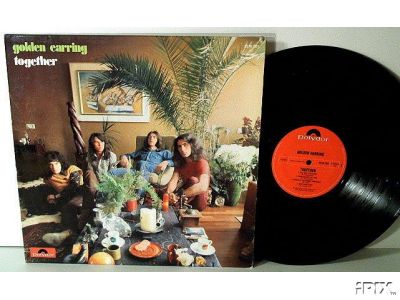
1973 - On February 24 1973 Golden Earring performed at the 'Hot Rock Night' festival in Germany. The concert took place in Düsseldorf, Germany and featured the bands Family, Hawkwind, Home, Golden Earring, Focus, Savoy Brown, Mick Abrahams Band and Vinegar Joe.
In March 1973 the band started another Germany tour again. Tourdates were published in the German Sound Magazine issues 2-1973 and 4-1973 at least. Taking a closer look at these schedules you see the band performed a lot of show in concesecutive days!
On April 18 1973 Barry Barry Hay and others spoke and protested at a hearing about the future of pirate radio station Veronica before the national government (Tweede Kamer). Later that day Golden Earring performed at the Malieveld in Den Haag in front of 100.000 Veronica fans who protested to the plans to stop the pirate station transmitting. The protest was the biggest demonstration ever held.
More info: in this review in Dutch.
Due to their succes with The Who on their 1972 European tour Golden Earring got signed to the (The Who) Track label.
After their signing up at Track Records Label Golden Earring started to promote themself in the UK and tried to get an entry to another European market. They went on tour in May and June with their support act Third World War. They even did some promotion at the prestigious Old Grey Whistle Test tv program on May 09, 1973 and played at the London Rainbow twice. (June 04 and 05, 1973)
Some more info about this prestigious tv program The Old Grey Whistle Test: it first went on air in September 1971 and became one of the most influential music shows for a generation. Despite it's low budget the show was a great success. Bands soon found their album sales would soar after an appearance. When the Old Grey Whistle Test went on air in 1971 it was unique. In a world accustomed to Top of the Pops, here was a show on which the bands performed album tracks and were interviewed after they had played. This was before the days of miming. The music was live and, since the idea was to air new sounds, many of the bands were making their first television appearance. Presenter Bob Harris recalls how the show's name was inspired by the doormen (in grey suits) who worked at the music publishing houses in London's Denmark Street, known as 'tin pan alley'. Bob Harris explained on the show "It was a 'tin pan alley' phrase from years ago. When they got the first pressing of a record they would play it to people they called the old greys. The ones they could remember and could whistle having heard it just once or twice had passed the old grey whistle test". The programme went out on BBC2, last thing on a Friday night, from a tiny studio on the fourth floor of Television centre. In the days before 24 hour television the station would close down at the end of the evening. This gave the last programme of the day some flexibility. If things were going well for the Old Grey Whistle Test they could stay on air. Some shows ended after 25 minutes while particularly good ones sometimes extended to an hour and a half. They had a budget of £500 per show, which was very low even in those days. In addition to the technical costs the artists themselves had to be paid. David Bowie, for example, played three songs and was paid £50. John Lennon refused to accept his fee in cash, insisting that he should be rewarded instead with chocolate Bath Oliver biscuits!
When bands were performing the sound was often so loud that the camera crew could not hear what the director was saying in their headphones. The programme makers continually broke new ground. The first ever 'simulcast' of radio and television , the first live transatlantic broadcast of a rock concert and the television coverage of Live Aid were all achieved by the Whistle Test team. Sadly, the programme is no more, having ended it's run in 1987, but it passed the musical baton to it's successors. A succession of programmes such as 'Later with Jools Holland', 'The Tube' and 'The White Room' have all drawn inspiration from Whispering Bob Harris's Old Grey Whistle Test. (Source: http://www.bbc.co.uk/southampton/music/ogwtindex.shtml
In the UK magazine New Musical Express of May 19, 1973 an article Earring is believing was published. It tells about the first experiences on the British market. Golden Earring have already been together for several years but, remarkably, are only just playing their first British tour now which is solidly booked through till June, are gigging all over the country and should cause a few heads to turn in the process. They performed at a recent reception held by Track records for them and the Third World War and, in contrast to the set-up at most receptions, they were given enough time to play a near-normal set. The audience warmed to them quickly and although it was their first gig here, they played an exceptionally fine selection of their funky jazz-rock material. Afterwards, as the alcohol was drained and the plumage wilted, the band's bass player/organist Rinus Gerritsen gave an interview to NME journalist Lindsey Boyd. Rinus Gerritsen was pleased with the way the performance had gone although was probably unaware of how catastrophic receptions can be for a band and therefore that Golden Earring had broken the customary barrier very quickly and effectively. "We're not accustomed to such a small stage - or such a small audience," he said. "When you're used to playing to 5000 people it's a bit strange to be faced with just a few." The journalist hastened to point out to him that, however diminutive the size, the gathering's reaction to the band's music should be far from disheartening. As one of Holland's most popular bands - their singles and albums can always be found lurking near the top of the charts there - it's surprising that they have never gigged in Britain before. "We've recorded here in the past," says Rinus, "but never managed to organise a British tour before. That was partly because of permit difficulties, a problem we no longer face. And since we've been involved with Track things have been better organised for us anyway."
However, their activities have not been limited to the Dutch market. When they outgrew their homeland they moved into Germany and their popularity throughout Europe resulted in an extensive European tour there with The Who in 1972. This, Rinus Gerritsen said, was a big boost for the group, a chance to be aired to a wide variety of audiences. (There have even been a couple of lengthy U.S. tours.) The peculiarity of Golden Earring's status here - their arrival on our shores with very little advance publicity at a fairly mature stage in their career - is a reflection of their experiences in the rest of Europe. Said Rinus: "Unlike most groups, we built up our reputation by playing live to people who did not have much idea of what to expect. As a result of these appearances we were able to sell a lot of records. Usually it's the other way round - a band gets a lot of publicity from a record and because of that people go to see them onstage. "We hope to do the same in England - to build up our audiences from scratch." The journalist said he thought that the bands that did make it that way - through the hard slog and the all-important emphasis on the live performance - were the ones who lasted longest in the end. "Yes," he said. "But it takes such a long time to get there." However, it has worked for them on the Continent so far and they hope it will do the same here. If that first appearance was anything to go by, they deserve to be seen by a lot in their one month in England. During the visit there will be discussions with Track on the nature of their next record release here. Then perhaps, they'll visit the UK again and we'll know what to expect from what is, at the moment, something of an unknown quantity.
Meanwhile the band performed the songs Just Like Vince Taylor and Radar Love already live during performances even before the Moontan album was released. On August 02 and 03 1973 Barry Hay and George Kooymans were guest in the Lexjo radio show on Dutch pirate station Radio Veronica. They were interviewed about their upcoming album and their musical choices were broadcasted on air. Also 2 songs from Moontan were broadcasted including Are You Receiving Me.
The band decided to release the Radar Love track as their new single in Holland.
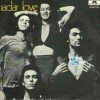
On August 22, 1973 Golden Earring played a football match in Zoeterwoude against voetbal Foto lith shop (A the Hague company) For Golden Earring Cesar Zuiderwijk, George Kooymans and Rinus Gerristen were in the team. Barry Hay could not play. The GE team lost with 2-1, this also was the score after 45 minutes. The only goal by Golden Earring was scored by George Kooymans reducing a 2-0 score.
The new album called Moontan was released in Holland on August 24 1973 (Catalogue info: Polydor 2925 017). On September 08 1973 the Moontan album entered the Dutch LP Top 20.
The band started their second UK tour on September 15, 1973 with a concert at the London Crystal Palace Bowl (Crystal Palace Garden Party), continued it on September 24 at the famous Marquee club and ended it in Colchester on October 07, 1973 as far as I know now. This tour was done to promote the release of the Radar Love single and the Moontan album. From this London gig a special program is known to excist.
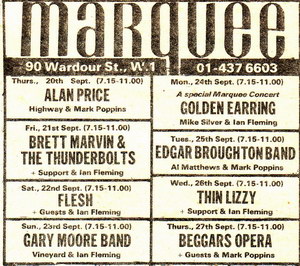
The forementioned concert at the London Crystal Palace Concert Bowl was a so called Crystal Palace Garden Party. The line up of performing artists was: Blue, Golden Earring, Backdoor, Tony Joe White (solo set), Lou Reed, Beck Bogart and Appice, The Section and James Taylor. It was a warm Autumn day with perfect weather (for most of the show at least), apart from some humidity. One of the big problems with the Crystal Palace Garden Parties was the presence of the small lake in front of the stage. This distanced the audience from the bands and made it harder for a rapport to be established between performers and artists. Basically the only people who could get close were the berserkers who were prepared to wade fully clothed through the water and get near the stage . This was ok on a warm day, but was not to be recommended in a British September as normally it gets pretty cold in the evenings once the sun goes down. However, this day was something of an exception.
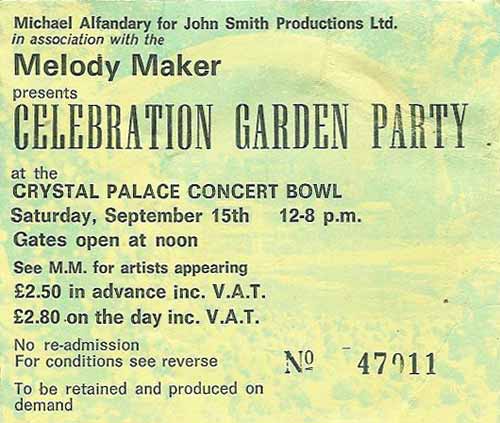
Golden Earring has been one of Holland's top bands for eight years now and was just now approaching generally deserved world-wide success as a good, flashy hard-rock band. But again there were moments the band thinks of ending their career. But just when they think of breaking up the release of new single ‘Radar Love’ changed everything. Only after long internal discussions the band could made their choice between Radar Love and The Vanilla Queen (Which was Cesar's favourite). Radar Love became the new single which was released August 1973. The doubt proved to be unnecesary! This song reached the first place of the Dutch Hitparade and became an alltime rock classic which is still played every Golden Earring show. On the B-side of the Radar Love single was the non-album track ‘The song is over’. This track is also available on cd sampler albums like ‘The Complete Single Collection Vol. 1 1965 - 1974’ und ‘Dutch Treat’. Radar Love became well known and still is due to it's incredible intro. Although the credits for the song are for Kooymans\Hay it was actually Rinus Gerritsen who composed this immortal intro. A fact which is not well known but one of the jewels to the Rinus Gerritsen crown. So success was rising for the band again! Golden Earring became much more mature as can be clearly heard on their new and magistral longplayer ‘Moontan’. ("No more speed, i'm almost there!")
The tracks that formed the basis of ‘Moontan’ were recorded in Hilversum and the overdubs and mixing were done in England (at the IBC Studio's). This was done at the same time as the various tours over there. John Fenton was a kind of godfather for Golden Earring during the time they spent in England. During long stays for recording and mixing new tracks they group stayed often at his home (at Knightsbridge, London near the famous Harrods store), drinking, eating and enjoying various other treats being popular at that time. Fenton, being a real Englishman, became a fine assistent to Barry "polishing" up the lyrics. They even lived for a few months in England.
With the release of lp ‘Moontan’ the band scored another high ranking topalbum. The "standard expedition issue" presented in the United States and Canada contained five songs only (including a re-recording of Big Tree Blue Sea!) but look out for the original Dutch release with the original (and much better) front sleeve and an extra two songs. (Suzy Lunacy (Mental rock) and Just Like Vince Taylor instead of Big Tree Blue Sea) 'Radar Love', the first track of the international album was a major hit for Golden Earring when it was released and still remains the single biggest reason for the whole album's popularity. With it's galloping rhythm and alternating phases of high and low intensity it somehow (well, the lyrics helped a bit) became the quintessential song for nighttime driving. Even today, it can be found in "Rock for the road"-type compilations, possibly next to 'Born to be wild'.
True enough, it is a great hard-rock song, but it's one fault is that it has outshined some of the diamonds in the remainder of Moontan. For example listen to the orchestral 'Vanilla Queen' with spacey noises and a sample by Marilyn Monroe. The Moontan album is a real product of the 70's that Pink Floyd and Alan Parsons would have been proud to call their own or listen to the newly recorded version of 'Big Tree, Blue Sea' rooted in the same fertile ground as the music of 'Caravan', 'Camel' and 'Jethro Tull'. There is a very wide range of musical styles on the Moontan album. Using AOR as their main axis, 'Golden Earring' combine other styles ranging from RnB, hard and progressive rock, all the way to psychedelia. Groups like the Rolling Stones, Deep Purple and Uriah Heep come unexpectedly to mind, but then, Golden Earring were very much a part of that generation. It may not be totally wrong to say that Golden Earrings contribution to the music of that era has been underestimated!
This 1973 outing is the album that raised Golden Earring to an international level of popularity, primarily on the strength of the hit single and enduring radio favorite "Radar Love." However, there is much more to this album than just that hit. In many ways, Moontan is like a summation of everything the group had learned on their first three albums from the seventies. It presents a similar combination of prog epics, heavy rockers, and songs that combine both elements, but everything is raised to a new level of inspiration and polish. Moontan starts with a bang thanks to "Candy's Going Bad," a piece that starts off as a thunderous, pounding rocker but transforms midway into a bluesy instrumental mood piece. Other highlights include the hit single "Radar Love," a relentless rock tune with a left-field instrumental break in which tribal drums duel with a big band-style horn section, and "Just Like Vince Taylor", a guitar-slinging slice of boogie rock that pays tribute to the fallen rock idol of the title. The album also includes what may be the group's finest prog effort in "Vanilla queen": this classic builds from pulsating, ominous verses dominated by synthesizer into a hard-rocking chorus and also throws in a stark acoustic guitar midsection before climaxing in a frantic band jam augmented by blaring horns and an ever-spiraling string section.
Some critics are divided and in their opinion Moontan also has some crippling pretensions. Despite the album's overall strength, not every song reaches these heights. Some of side two's songs have long, tedious stretches of instrumental meandering in their opinion. "Are You Receiving Me?" recycles some hooks from the group's past classic "She Flies On Strange Wings," and the twangy country-pop of "Suzy Lunacy (Mental rock)" is a little too poppy to gel with the rest of the album. However, even these tunes benefit from tight arrangements and a spirited, totally committed performance from the group. The result is an album that retains its power today. In the end, Moontan is a necessity for Golden Earring fans, and a worthwhile listen for anyone interested in 1970s rock at its most adventurous. Success came like a landslide as Moontan sold over a million copies in the USA alone with the single Radar Love and many live shows as it's promotor...
The album sleeve did get much of attention internationally. The nude dancer on the fold out cover raised problems in the United States. The first print of the album (MCA\Track 396) was like the European one (Polydor 2925 017), but soon the sleeve was redesigned and completely changed into an "ear-design cover with Earring" (MCA\Track 2352) On the Spanish censored release the girl was given a "bikini" as some mention it. The cover is edited with the nude dancer girl holden a blue and white playing card with the heads of the 4 Golden Earring members on it. In England the album was released on the Track Records label (Track 2406 112) and the sleeve design even got awarded for it's outstanding look! Also the tracklisting was changed. For the American market two songs from the European release were replaced by a re-recording of the "Big Tree Blue Sea" track. The album is also released in Japan and then has a so called OBI with the release. This album was released on the Polydor label with label number MP-2408.
In 2013 finally was dicovered who the nude model was at the Moontan cover. The search for the model on the cover of Moontan has succesfully ended! The model on the cover is almost certainly Jilly Johnson, a famous British model, who said: "Yes, absolutely right. It was shot in Amsterdam. But how would have anyone have guessed it was me!" Brian Kitchen, together with Ian McCann, Editor of Record Collector in the UK, found her. (See Record Collector Issue 428 June 2014) Info thanks to Golden Earring Radar Love 1973 Facebook page!
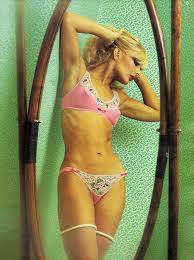

There was quite an argument as to which song to release on single, Radar Love or Vanilla Queen. Cesars preference was for Vanilla Queen, but finally the band decided on Radar Love, because of it's being very "danceable and disco-friendly" (very Seventies). Partially thanks to it's success in the States, number 13 in the Billboard Hot 100, it looked liked their boyhood dreams were coming true. Radar Love remains a superbly mesmeric highway rocker, complete with a delightful reference to Brenda Lee's 1966 "Coming On Strong" and a great hook of a chorus. Golden Earring became a band to reckon with on the international music scene...
Barry told the following about how the lyrics of Radar Love were written: "One evening I had a few friends over, one of whom was American, and I was brainstorming with them about the form and contents of the story. It had to be something very simple, to which every average person could relate, such as someone in the bathtub and ... Everyone started to put in ideas and it when it got too chaotic I kicked them all out of the house and sent them to some nightclub so that I could work in peace. The idea of an ordinary guy in his car began to take shape and when my American house guest got home in the early hours and read the lyrics, he went wild: This is it, brilliant! The ultimate American car song!!!"
The song Radar Love referred to a composition with the line "The radio plays some forgotten song, Brenda Lee's "Coming On Strong". Brenda Lee recorded her song "Coming On Strong" on August 10, 1966. This composition from David Wilkins entered the Billboard Hot 100 on October 01, 1966 and has #11 as highest position. Barry Hay's mother loved the songs of Brenda Lee. She was sitting on the couch with a cigarette and a glass of wine while listening the music of Brenda Lee. The line "Brenda Lee's Coming On Strong referred to this and so Barry must have been influenced by the song.' The intro for the Radar Love song is heavily influenced by the bombastic sound (of the music) of Santana Rinus Gerritsen admitted once.
Some UK photo's (thumbs) from August and October 1973 performances...
"Radar Love" is that rarity of the early '70s: a song that works both as an extended, "progressive" album track and as a hit single. Golden Earring's 1973 US album ‘’Moontan’’, itself a reworking of an earlier European release, was targeted at the then-expanding FM progressive rock radio audience and seemed an unlikely source for a breakout hit single: five extended jams averaging over eight minutes per song. Kudos, then, to the unknown engineer who took "Radar Love", which at a relatively compact six-and-a-half minutes was already the tightest of the album cuts, excised the instrumental solos (save for a great drum-and-synth break which became the focal point of the short version) and tightened the opening and closing, creating a sparkling single half the length of the original jam. Lyrically, "Radar Love" is a murky tale of late-night driving and ESP; the real attraction is the non-stop parade of musical invention, from the aforementioned intro and drum solo to the twin guitar responses to each vocal line in the last verse to the cascading synthesizers that crash the tune to a close.
Radar Love is covered over 800 times (2023) and used for several movie soundtracks as well. Check out the Radar Love website. Inspiration for the song came from Santana's music (as said by Rinus Gerritsen in an 2003 interview for tv serie Nederpop met Hart en ziel)
The European version of the Moontan album also contained the curiously titled 'Just Like Vince Taylor'. Golden Earring have since gone on record to reveal that Vince Taylor was of English descent and built a career for himself in Paris during the Fifties, a leather bedecked rock 'n' roller, clearly a man who had made a big impression on one Barry Hay! The USA version of the album has a re-recorded version of Big Tree Blue Sea track on it instead.
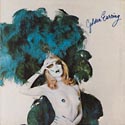
They shot the clip for ‘Radar Love’ at their hometown in the Zuiderpark Open air theatre, located in the Zuiderpark neighbourhood where they did grow up. In this clip you could see the legendary jump Cesar makes over his drumkit and the Golden Earring members while driving in a car through Holland in the night through the Schiphol tunnel. It also shows their improved performing skills which were developed during the intensive touring in the years before.
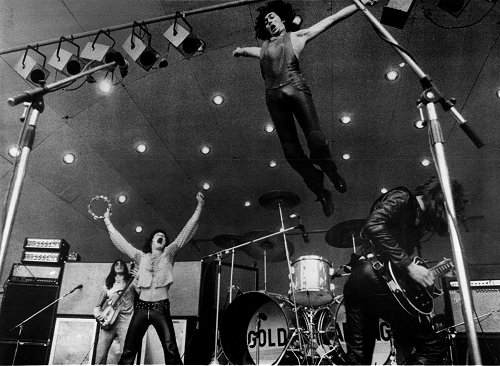
In October 1973 the Radar Love single entered the German hitlist and reached highest position #5.
On October 05 & 06, 1973 Golden Earring performed at the London Rainbow theatre probably as opener for Lou Reed who was on the European leg of his 1973 "Berlin" Tour ("The Rock And Roll Animal Tour"). This date info is found on the text sheet of a live recording which surfaced on the internet. The recording is made on October 05, 1973 and gives an impression of the material of the upcoming album Moontan performed at the end of Golden Earring's second UK tour. Barry Hay announced the first live performance of "Just Like Vince Taylor", b-side to their single Radar Love. When Golden Earring took to the stage on this night, they were introducing Moontan material to the London audience for the first time. Although limited to a 40-minute set, they pack a serious punch into the time allotted. They kick the set off with "She Flies On Strange Wings," the George Kooymans penned opus that became the single from their 1971 album, Seven Tears. Originally divided into two parts on the single, here it is expanded even further, clocking in at nearly 11 minutes and featuring an extended opening sequence and adventurous playing throughout. This is a prime example of the way the band would often begin a song calm and mysterious and gradually build up the intensity level. They next announce that they'll be performing the b-side of their forthcoming single and launch into the eclectic country-influenced rocker, "Just Like Vince Taylor." Next up is "Big Tree, Blue Sea," originally featured on their self-titled 1970 album and revamped with an additional flute arrangement for the Moontan USA album version. This is another highly adventurous modular piece, with obvious similarities to later era Jethro Tull and having a distinct progressive-rock bent. Initially mixing electronics and flute over a delicate groove, this eventually develops into a lengthy hard rocking guitar workout, epitomizing the Moontan-era sound they were now developing in concert. From the between song banter, it is obvious that the band is in very good spirits here and the performance reflects this. But nowhere is their enthusiasm better reflected than on the set-closing "Radar Love." Brand new, this highly ambitious number is crackling with energy. From the opening bass riff, it is obvious that Golden Earring is on to something special here. This song would, of course, go on to become a career-defining moment for the group, and hearing it when it was so fresh and new is undeniably exciting. A fitting ending to a set of ambitious music when Golden Earring were arguably entering the most spectacular stage of a career that has attained incredible longevity.
Radar Love was released on single in the UK on October 26, 1973 by Track Records. DJ's could order an advance copy of the single by filling out a coupon in the UK magazine Melody Maker dated October 06, 1973. They had to promiss they wouldn't play it in public before October 12, 1973. The UK Moontan album has the label number Track 2406 112.
The band started their third UK tour on November 30, 1973 at Hastings and ended it in Manchester on December 17, 1973. Fans reported the December 14, 1973 concert at the Scarborough Penthouse was called of at the last moment probably due to a too small stage. On December 08, 1973 the Radar Love single entered the UK hitlist and finally reached highest position #07, while over 250.000 copies were sold. To commemorate this Track Records gave awards to sellers. There are known examples of such an "award"". On one of these awards the text underneath says: Presented to VERNON BREWER to recognise the sale in the United Kingdom of more than 250,000 records of the Track single playing record "RADAR LOVE". (picture silver disc Radar Love UK) This 1973 single has label number Track 2094116 but on October 08, 1977 Radar Love in a live version (from the (Live 2-lp) entered the hitparade again but then the highest position was only #44.
According to an article in UK magazine Melody Maker dated January 12, 1974 called The Golden Earring file the band transported their equipment in a Mercedes truck, the band themselves uses a Mercedes car. Tour manager was Maarten Baggerman and the PA system was made in Belgium after an American design by Faylon. It comprises bass bins with JBL speakers, mid-range and high-frequency tweeters, Faylon amplifiers and quadrophone sound mixer plus Shure pofessional mikes. Total power 2400 Watts.
On December 22, 1973 the German TV program Disco program broadcasted Golden Earring play backing Radar Love at the Disco tv show. Golden Earring at that time ended their third UK tour.
In 1973 a Buddy Joe cover was released by:
1973 France: Jean Pierre Besson - Buddy Joe\Ne me dis pas good-bye (7" Philips 6009-343)
1974 - Golden Earring seemed to have reached the top in their home country The Netherlands. Both on stage and on record they may be considered Hollands most experienced and most succesfull group. They spread their wings to several European countries and early 1974 they played in Germany as well.

On February 15, 1974 Radar Love entered the Austrian Hitparade at position 19 and was charted for 12 weeks with highest position 10 on March 15, 1974. The last notation was on April 15, 1974 at position 13. This hitparade only published once a month a list and every months notation stood for 4 weeks. That way Golden Earring had three monthly nottaions in the Austrian Hitparade Chart.
In England the band toured with their (Dutch) support act Alquin in Spring 1974. They started their fourth British tour on February 28, 1974 at the Cheltenham Town Hall after a 4 day recording session in a London studio. This tour brought the band in well-known English venues due to the British Top Ten Radar Love single success. The band is succesfull but sometimes misfortune struck as well. Golden Earring cancelled their scheduled appearance at Croydon Greyhound on May 03, 1974. The official explanation they gave was "technical reasons with their equipment". Members of the public, some of whom had been waiting up to two hours to secure tickets, were annoyed that the gig was not called off until 5.30 p.m. Golden Earring fulfilled the Croydon commitment on Tuesday March 05, 1974 however and the attending visitors went wild. The March 09, 1974 Melody Maker (UK edition) carried a review from the Golden Earring gig at Bristol University on March 02, 1974. For this fourth UK tour Golden Earring used the lighting equipment of the Who, this was a courtesy of The Who's guitarist Pete Townshend.
A review of the March 04 1974 Birmingham show was published in New Musical Express March 23 1974.
A review of the Croydon show was published in Record Mirror magazine March 16 1974.
Another review of the March 25 1974 London Rainbow show in New Musical Express March 30 1974. The Dutch Oor Magazine carried an article about this show as well. In the article it's mentioned George has amplifier had problems in the first song.
Radar Love became silver awarded. On the British single release (Track 2094 116) Just Like Vince Taylor was the b-side. This track is on the European Moontan release but not on the UK and USA releases as these have a different tracklisting. A new version of "Big Tree, Blue Sea" on the US release replaced the tracks "Just Like Vince Taylor" and "Suzy Lunacy" from the European release. Also has the original cover that was banned in the States. Golden Earring signed to the Who's Track label, which released a compilation album called Hearing Earring in the UK, helping the group break through in England. Especially Barry Hay's stage performance played a crucial role. Meanwhile the other bandmembers are great entertainers too. The great guitar solo's by George and the famous leap over the drumkit by Cesar as well as the internationally acknowledged bass player Rinus made the band a fine live act to watch. Now the success in Engeland was finally there, all Earring fans hoped this would soon be the same in the Unites States too.
"Radar Love" was the worldwide breakthrough hit by the Dutch rock band Golden Earring. The song is considered by many to be among the greatest "driving songs" ever due to its lyrics about driving all night, its up-tempo beat, and its catchy sing-along chorus. Dutch and German fans knew Golden Earring (and their early incarnation The Golden Earrings) as a second-tier pop/psychedelic group dating back to the mid-1960s, but for most listeners in the United Kingdom, United States and Canada, the first exposure to the group came in 1973 with the crashing 14-note guitar-and-cymbals introduction to "Radar Love" on the local top-40 radio station. "Radar Love" is that rarity of the early '70s: a song that works both as an extended, "progressive" album track and as a hit single. Golden Earring's 1974 US album Moontan, itself a reworking of an earlier 1973 European release, was targeted at the then-expanding FM progressive rock radio audience and seemed an unlikely source for a breakout hit single: five extended jams averaging over eight minutes per song. An unknown engineer took "Radar Love", which at a relatively compact six-and-a-half minutes was already the tightest of the album cuts, excised the instrumental solos (save for a drum-and-synth break which became the focal point of the short version) and tightened the opening and closing, creating a single half the length of the original jam. Lyrically, "Radar Love" is a tale of late-night driving and ESP; the real attraction is the non-stop parade of musical invention, from the aforementioned intro and drum solo to the twin guitar responses to each vocal line in the last verse to the cascading synthesizers that crash the tune to a close. Golden Earring wouldn't have another stateside hit until 1982, with the MTV-ready "Twilight Zone", but "Radar Love" remains a rock radio staple and their defining moment. The song has been covered over 300 times over the decades, including versions by U2, R.E.M., Blue Man Group, Def Leppard, James Last and Santana. GOLDEN EARRING Radar Love Track 7" 2094116. C/w Just Like Vince Taylor.

Tracks from the albums Together and Seven Tears were taken to make the album Hearing Earring for Australia and the UK and released on the Track Records label. So fans will miss some songs if they don't have the original Dutch albums mentioned. It had a special braille message printed on the cover for those who are visibly disabled. Untill now I have never seen this before on a record sleeve...
During the last four days of February 1974 another single called Instant Poetry (A non-album track!) was written, recorded and produced at the London based IBC Studio, with Damon Lyon-Shaw as the studio technician. A reference lacquer was cut on March 07 1974 at Trident Studios, and after the band's approval, a stereo copy master was mixed on March 20 1974 at I.B.C. according to info in the liner notes of the Remastered and expanded version of Moontan cd. The lacquer is in the collection of Golden Earring Fan Jeroen Ras. Coming hot on the heels of their international success Radar Love Golden Earring managed to get their 20th Top 40 entry in 1974 with Instant Poetry. The single was in the charts for nine weeks and reached the third place in the Netherlands, but internationally this single didn't lead to any attention. The clip for this song was filmed at a garbage dumpsite at Beverwijk, Holland. But there also excists a studio recording from Avro's Toppop, broadcasted on May 06, 1974. The fans couldn't understand the change of music again. Although definitely not in the same class as its illustrious predecessor Radar Love, the single enjoyed a decent success in Holland. This in spite of some very strange lyrics like "Washing machine, space age dream, let me serve you, keep me clean - Rinse me plain, spin me sane, I'll trust my dirt to only you - Automobile, see me kneel, I'll scrub your back, I'll buy your meal, I'll choke your start, I'll warm your heart, I'll dream of dying just with you". It was very different compared to the tracks on Moontan and especially George was dissappointed about the lack of success for the single. The B-side From Heaven From Hell (also a non-album track) is an alternative, different version than the one which is on the "Together" album.
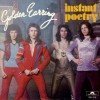
The single was released in Germany as well (Polydor label 2001 518) and Belgium. The German issue has a cover with a picture taken while Golden Earring performed at the German Disco tv program. The single was also released in the UK (With b-side From Heaven From Hell on Track label 2094 121) but it became no hit. The single was also released in Australia (Polydor 2001 518) in 1974 but in a company sleeve, no picture cover. Radar Love and Instant Poetry are also released in Spain with different covers and Spanish titles! (Instant Poetry is Poesia Actual) They also did a promotional Spanish tour in at least 6 venues as showed on the flyer underneath. The tour included six shows in Bilbao, Pampalona, Zaragoza, Irun, Barcelona and Madrid. All the mentioned Instant Poetry singles from different countries all have a different cover compared to the Dutch one!
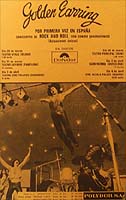
While already being famous and a "supergroup" in their home country Holland the final breakthrough abroad was initiated by their hitsingle "Radar Love". While in England succes was already there and looked promising for their future, Radar Love became a big hit in the USA also. On May 11, 1974 Radar Love (B-side: Just Like Vince Taylor) entered the USA Billboard hot 100, highest position #13 and was charted for 20 weeks (Catalogue info: Track/MCA 40202) and became a classic rock song. Their album Moontan was released in Spring 1974 in the United States and Canada on the Track label (Due to their good connections with the Who and their 1972 European tour). The album has a different cover and different track listing than the original Dutch release. The Dutch issue featured Just Like Vince Taylor and Suzy lunacy which were replaced for the American and Canadian markets by a new recorded version of the Big Tree Blue Sea track. In the USA the nude cover has been sold for a short period only before it got banned and was soon after the release replaced by a sleeve version with an ear and earring.
Meanwhile former record label Capitol records wanted to make some money with an old Golden Earring release now Golden Earring became succesfull in the United Stateds and re-released in May 1974 the 1967 Winter Harvest release (CAPITOL ST-2823) with label number CAPITOL ST-11315 (This re-release album has an orange label and a changed sleeve similar to the USA Moontan album cover but this time with a yellow star like Earring).
The Moontan album was released in 1974 in the USA and spawned the single "Radar Love," a Dutch number one, U.K. number 4, Germany number 3 and U.S. number 13 hit! On the waves of their succes Golden Earring crossed the ocean again. During their new USA tour the band met an enthousiastic audience and the American break through seemed to be a fact. On June 15, 1974 the Moontan album (USA version) debuted on the Billboard album charts, highest position #12 and was charted for 13 weeks (catalogue info: Track 396). On June 22, 1974 the USA Radar Love single entered the US Billboard Hot 100 Chart, 10 weeks in the charts, highest position 13 (Source: The Billboard Book of Top 40 Hits by Joel Whitburn)

During this Summer 1974 tour they opened at least 4 shows for Procol Harum. (May 07, 1974 at Cincinatti University (with Billy Joel as opener as well), July 03, 1974 at Houston Colliseum, July 04, 1974 at Dallas memorial auditorium (Both with Poco as opener as well) and July 07, 1974 at St. Louis Ambassador Theatre). A small review of the Houston concert can be found in the Melody maker of July 20, 1974) Also here is (a part of) the text from local paper Houston Chronicle of July 1974: "There were enough people at the Procol Harum concert Wednesday night to fill the Music Hall. Almost. Unfortunately, the British band, along with Poco and Golden Earring played in the cavernous Coliseum and that was the first mistake of many during what became a five-hour show. It all started on the wrong foot with Golden Earring, a hard rock band from Holland following closely on Focus’ footsteps in trying to win an audience in America. But unlike Focus, with its distinct classical and jazz roots, Earring is more commercially patterned after already established rocks [sic] bands, specifically Who [sic] and Jethro Tull. The band lays down a solid rock'n roll beat, but falls short of embellishing it with anything more than worn-out theatrics. The band is good at attracting attention, but needs a little practice in keeping it." Another review is in the Houston Post of July 03, 1974.
On June 06, 1974 Golden Earring was depicted on the front cover of the USA Scene magazine. Inside the issue was a one page interview. Meanwhile the band did several shows at the New York Madison Square Garden as a support act for The Who. This band gave shows on June 10, 11, 13 and 14, 1974. The band sold 80.000 tickets within 16 hour after the broadcast of a single 60 second radio commercial! Which of the four shows Golden Earring supported is not really clear to me.
Contrary to other Dutch performers like George Baker (USA hit Little Green Bag) and Shocking Blue (USA hitsingle Venus) which were known from their hits and not as a touring act Golden Earring always acted as a performing band and tried to get a hitsingle. As we all know this strategy finally worked with result their huge megahit Radar Love. On June 25, 1974 Golden Earring's single Radar Love entered the Cashbox US Singles Hitlist on position 28 and the Moontan album entered the Cashbox US Album Hitlist also on position 28.
On July 12, 1974 Golden Earring performed with Brownsville Station (whom they performed with in January 1970 as well during Golden Earring's second USA tour!) and I found a poster for this show on the internet.
Golden Earring was asked to support Rick Wakeman at the Crystal Palace Garden Party on July 27, 1974 (UK). Golden Earring should fly into Britain specially to appear in the Garden Party event at Crystal Palace Bowl in South London on Saturday, July 27. They would join Rick Wakeman, whose first gig since leaving Yes was booked. (Source New Musical Express June 29, 1974) Golden Earring had to cancel however due to health reasons according to Melody Maker July 13, 1974. The band by then would have just returned from another USA tour, so this might also be the reason... On July 23, 1974 Golden Earring returned at Schiphol airport from their USA tour.
Golden Earring appeared at the well known "Midnight Special" were they performed Radar Love and they were announced by the legendary Little Richard. This episode (no 80) of the Midnight Special was first Aired August 16, 1974. Fans might notice that at this occasion George Kooymans does the lead vocals as Barry Hay had voice problems. This performance can be seen at the well know You Tube site. On the "Burt Sugarman's The Midnight Special Legendary Performances - 1974" dvd the following text can be found: "These performances feature an incredible array of the greatest musicians of the 1970s and early 80s, The Midnight Special stands alone in the history of rock ‘n’ roll as the first ever late-night live concert show on TV, capturing the spirit of a time when rock was exploding in so many new, exciting directions. For nine thrilling years, The Midnight Special brought audiences the very best live music from every genre rare performances right into homes every week complete with the intimacy of close-ups and multiple camera angles that placed you right there with the on-stage action. It was an exciting time, and it’s now been restored and re-mastered in this exclusive series. So kick back, relax and enjoy the show from the best seat in the house."
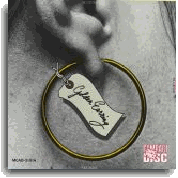
The Moontan album (on Track/MCA-Records) became the RIAA (Recording Industry Association Of America) certified gold status on September 20, 1974 in the USA for over 500.000 copies sold. In the United States, the Recording Industry Association of America awards certification based on the number of albums and singles sold to retail and other ancillary markets. (Some other countries have similar schemes. Certification is not automatic; for an award to be made, the record label must pay a fee to have the sales of the recording audited. These Gold® awards have undergone many design changes since their beginnings in 1964 and have become true collector's items. Golden Earring received the so called "White Matte" (first) version of the RIAA Gold award (which was given from the start of program untill 1975 when the award design was changed) The plaques were an off-white linen material displayed in an unpainted, finished wood frame. The dedication on the plate was engraved with an etched RIAA® seal and a mini-cover of the LP was mounted separately from the plate. The International Federation of the Phonographic Industry (IFPI) administers a similar award system for a number of countries excluding the United States. This system includes Silver, Gold, Platinum and Diamond award categories and is generally based on the RIAA system, although U.S. sales are not included in the counts. Soon after this Golden Earring left for the USA again on September 27, 1974 to do another USA tour and returned on November 05, 1974. Amongst the concerts were several shows as special guest for Santana.
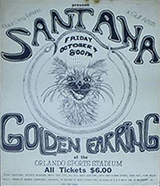
The chart positions reached by Moontan and Radar Love resulted in long lasting (3rd and 4th.) tours in the United States. They performed with many well known bands such as Santana, J. Geils band and the Doobie Brothers. The band started their USA Fall'74 (4th) tour to promote Moontan some more. They played together as Santana support act, did several shows as headliner on their own and performed live for the prestigious "Don Kirschners Rock concert". In 1974 he band Supersister had decomposed quite quickly and Robert Jan Stips was ready for take off, looking out for a surprising challenge, which he found almost the next day when Cesar Zuiderwijk paid him a visit with the question if he would like to join forces with Golden Earring, to strengthen and enrich their sound on their next coast to coast USA tour starting ...10 days later... So Robert Jan Stips was added to the line-up for the USA Moontan album promotion tour. From Moontan over one million copies are sold worldwide! That distinct musicians Robert-Jan Stips (ex-Supersister, later the Nits plus Freek de Jonge) and Eelco Gelling (ex-Cuby & the Blizzards) briefly joined in the latter part of the Seventies, was mainly meant to boost the bands technical capacity. Robert Jan Stips about his contribution to the band: "That was true to a certain extent. They literally told me, they were striving for a wider musical scope. My input eventually resulted in the album ‘To The Hilt’, still a very interesting record. Yet the Earrings’ instrumental standards are often under valued. If you could hear George playing in the changing rooms, your jaw would fall to he ground." (taken from a translated 1999 interview)
Golden Earring became well known in the United States now and the prestigious American Rolling Stone magazine had an article about them. In the same magazine a 'Thank You' add can be found regarding their just finished American tour.
An American fellow posted many years later the following remark on his web log: "Golden Earring is the first band I saw that ever had a brush with greatness. It was in St. Louis, Missouri at a hotel. Our family went to breakfast in the hotel and we were seated next to a group of guys-many of who had long hair-who were intently perusing through the local morning newspaper. They would read aloud from a page and then pass it to another person. After a few rounds and a few sips of coffee, the group left and had it not been for my dad, I would have never known how close I was sitting next to a bona-fide rock band. "I think those guys are from Golden Earring." He announced to mom and I after they were well out of earshot. They were reading a review of their show from the night before, and apparently my dad, who was reading his own copy of the St. Louis Post-Dispatch, came across the same article right around the same time that our table neighbors did. This was around the time of "Radar Love", a song that was played constantly on the radio. I was too young to know anything about asking for autographs, but I did question why my father didn’t just simply go up to them and ask 'Hey! Are you the guys from Golden Earring?' It would have been awesome to go back home, stretch the true a bit and tell all my second-grade friends that I had breakfast with Golden Earring. Years later, Golden Earring scored their second hit single quite a while after the first. “Twilight Zone” sounded quite different from "Radar Love" and it took a few listens to "get" the hook. There was something about "when the bullet hits the bone" that just doesn’t stand up and say, "You wanna be startin’ somethin’?"
Meanwhile the band did record for their new album called Switch at the Soundpush studio's Blaricum, Holland just before leaving for their Fall'1974 USA tour. These album recordings took place from August 26, 1974 untill September 24, 1974 with Robert Jan Stips amongst the musicians. This new album, which had the working title "Up And Down Absurdia" would be released later in the year so was expected.
Another single was released on the American market called Candy's Going Bad (MCA) to promote the Moontan album some more. (At the end of 1974 already 700.000 copies of Moontan were sold in the USA) On the b-side is the track edit version She Flies On Strange Wings part 1. The white label promo version carried a mono and stereo version on it. (MCA 40309) This single was released in Canada and Great Britain (on November 08, 1974) also but not in Golden Earrings home country Holland! From the UK Candy's Going Bad single version a yellow-label promo excists. (Track Records 2094 126) Their new album, which has the working title of "Up And Down Absurdia", will be released later in the year.
Golden Earring returned to England and performed at the prestigious Old Grey Whistle Test tv program again on November 12, 1974. (At this performance Robert Jan Stips played along and two songs were played: Candy's Going Bad and a kind of preliminary version of Love Is A Rodeo, with different lyrics)
From the Candy's Going Bad USA pressing, there is also a white label promo pressing released with label number Track 40309. The tracks are Candy's Going Bad (Mono A-side) and Candy's Going Bad (Stereo B-side). The label mentions "Recorded in Holland Play it loud." Needless to mention this, I would say as it is a great track! In 1974 Who manager Kit Lambert and the band put an end to their business relation and soon afterwards Track Records was out of bussiness due to financial troubles. On October 19, 1974 Candy's Going Bad (B-side: She Flies On Strange Wings) entered the USA Billboard hot 100, with highest position #91 and was charted for 04 weeks (catalogue info: Track/MCA 40309)

Golden Earring did at the end of 1974 their fifth UK tour with Lynyrd Skynyrd (November 14 - December 03, 1974, 16 shows). For these shows a 16 page tourprogramma was issued featuring eight pages on each band. On November 22, 1974 Golden Earring performed at Oxford's New Theatre, but their special guest act Lynyrd Skynyrd was forced to cancel their appearance as lead singer Ronnie van Zant was suffering from a minor throat infection. Doctors advised him to rest his voice for 24 hours ( as stated in NME magazine November 30, 1974) The bands then performed together again at the London Rainbow on November 23, 1974. However on November 24, 1974 the gig at the Theatre Royal Norwich was called off for Lynyrd Skynyrd again due to illness of two of their bandmembers. Lynyrd Skynyrd was replaced by top London 'last minute replacement' band Isadora who was said to blew the Earring off the stage but the highlight of the show was Cesars famous leap over his drum kit at the end of Golden Earring's set amidst fireworks! For that tour also t-shirt were made with a Skull print with cross bones and text Lynyrd Skynyrd on one side and the name Golden Earring, a black panther head and the UK tour dates and places are below on the Golden Earring side. For this tour a button-style backstage pass was used with the text "Golden Earring backstage pass". For the band Lynyrd Skynyrd this was their first visit to Europe. In several UK music magazines like New Musical Express and Melody Maker you could find a large advertisement with the UK tourdates. The November 1974 issue of the USA Beetle magazine featured an article called GOLDEN EARRING: "Ear Piercing Rock"
In 1974 Bertus Borgers, who played along on several Golden Earring tours and albums, went into the studio's and recorded demo's for his to be released first soloalbum. On this demo is a song called "Tighten Your Belt" with Cesar Zuiderwijk, Rinus Gerritsen, Robert Jan Stips and Eelco Gelling. Soon after the recordings Bertus Borgers went along with Golden Earring on another USA tour. After this tour he joined the band Sweet d'Buster (with Robert Jan Stips as well) which split in 1980. Only after this split Bertus Borgers released the recordings called Demo's 1974. At first sight you don't recognise the afore mentioned musicians but when you look at the tracklist and you see the musicians summed up it became clear several Golden Earring members palyed along! The musicians mentioned on "Tighten Your Belt" are Chè Chu De Viecg (Cesar Zuiderwijk), Rus Garoedsen (Rinus Gerritsen), Robo Switch (Robert Jan Stips) and Co Schnelling (Eelco Gelling)

Group 1850 was joined by Barry for their recordings of the Polyandri lp. He played flute on the song Silver Earring. The recordings for this lp were mainly made in January 1974. The release was on lp in 1975. (Rubber label, label number RR 1851) The album was re-released in 1997 on cd (Twilight Tone label, label number TT 013) and in 2006 again on the Progressive line label.
1975 - In January 1975 George Kooymans and his wife Milly moved from Soest to Belgium and bought a house near the Dutch border in a small village called Rijkevorsel. January 03, 1975 the band got the Dutch Conamus Exportprice 1974 for their complete works from (Fred Haayens neighbour and former minister) Norbert Schmelzer at the international press-centre Nieuwspoort (Hofsingel, The Hague). However Golden Earring refused to go on in the style of the successful Radar Love and changed it's musical directions when recording the pretentious album ‘Switch’. One day later on January 04, 1975, the band flew to the UK again to mix their album at the IBC studio's, London, England.
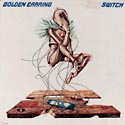
As they didn't wanted to make the "son of Radar Love" the band made a "switch" in many aspects. For this record an extra band member Robert-Jan Stips (Former member of Supersister) on keyboards was now permanently added to widen their artistical horizon. The band has a new sound now as well as a short haircut and a trendy way of dressing. During the Switch-tour there was a horn-section added. Bertus Borgers on saxophone and Karl Kalf on trumpet (Ex-Dizzy Mans Band).

For the Switch tour the white drawing doll from the album cover was made in white plastic and lifted up on stage behind the band. A bright and brandnew all white stage floor, a new show, a new lighting design and a new quadrophonic sound equipment completed the success.
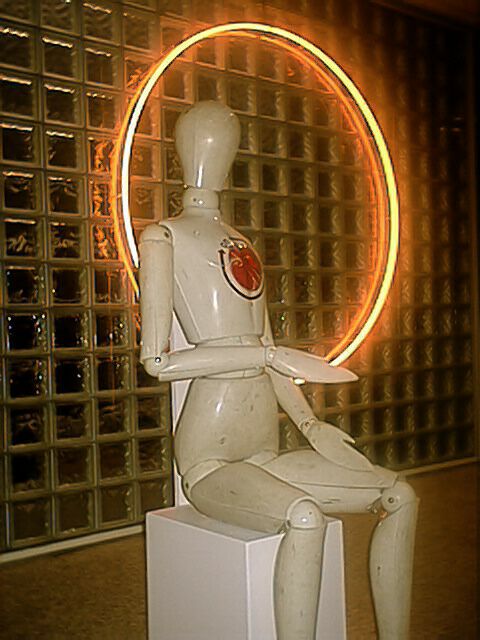
Benny Behr, a famous Dutch studio violin player, did play Robert Jan's string arrangements like Forever and Ce soir. All very different compared to the previous period. The single Ce Soir (edit-version of the longer lp-track) reached a top-10 position in The Netherlands in no time but elsewhere the success was less as the fans abroad didn't knew what to think about the change in music. The artistical horizon was widened but commercial success went down equally or even harder...
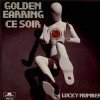
On February 15, 1975 George Kooymans, Cesar Zuiderwijk, Robert Jan Stips and Bertus Borgers played along live with each other in the Sweet Okay Supersister project at the Amsterdam Paradiso.
On February 22, 1975 the single Ce Soir became Alarmschijf and entered the Dutch national Top 40 hitlist on March 01 1975, it's highest position in that cahrt became 05 and finally ended up 8 weeks in the Top 40charts (Catalogue info: Polydor 2050 353)
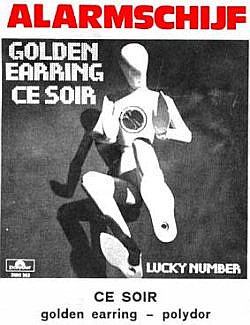
During the show on February 27, 1975 at Breda in the Turfschip George his white trousers got torn in the crotch, nevertheless he kept on playing and finished the whole show with the tear in trousers! Support act for this show was Galaxy Lin, who did several shows with the band at that time. A day later Robert Jan Stips performed at the show in Voorburg (Vliegermolen) in cycling clothes. From both "special events" photo's were made by a fan.
At the end of April 1975 the Switch album had reached the number one position in the Dutch album charts. The Switch album was also released in Japan and is known to excist as a white label promo as well (with OBI strip on cover)
The band went to the States again for their fifth USA tour on April 03, 1975 and returned in the Summer of 1975. In the USA a promotional poster the Switch album is known to excist. The poster measures about 22" x 34" inches, is in full color, by MCA / Track Records 1975. Also known to excist were Switch iron-on transfers. You could make your own vintage Golden Earring t-shirt with these iron-on transfers. They came in a piece of parchment, to which the rubberized artwork is attached until ironed on to a shirt. The size of transfer (diameter) is about 9 inches. I'm not sure whether these items were sold during the tour or if they were used for promotional purposes only. The Switch album was released in the USA on MCA\TRACK records label with label number MCA-2139 in 1975.
From the "Switch" tour a FM recording in a "B-" quality was aired by KSAN Radio Show (San Francicso)and featured somgs like The Switch and Big Tree Blue Sea. The radio broadcast was used later on for a bootleg called Live In New York
From The North American Switch USA tour at least 4 recordings are known to excist: Calderone Hall - New York City, Massey Hall - Toronto, Winterland - San Francisco and Record Plant Mobile, which is probably a soundcheck for the Calderone Hall gig. The setlist for the May 28, 1975 Toronto gig is:
Plus Minus Absurdio, Candy's Going Bad, The Switch, She Flies On Strange Wings, Big Tree Blue Sea, Love Is A Rodeo, Daddy's Gonna Save My Soul, The Vanilla Queen and Radar Love.
The May 1975 USA Circus magazine had a poster from Golden Earring's Barry Hay in it (nicely dressed in red!) and probably an article about Golden Earring and the June 1975 issue of the USA Circus magazine carried a full colour Golden Earring poster i'm informed.
Golden Earring released another single in The United States called The Switch. The US white label promo of this single has both Mono and Stereo versions on it. (Track\MCA records MCA-40412)
Also the international press couldn't place the musical change of direction and got confused. Symphonic songs and rock songs beside a reggae song didn't fit into a certain profile so the band lost their media attention build up with Radar Love and Moontan. Another single released was Tons Of Time (Catalogue info: Polydor ).

Arcade Records released a lp sampler called The Best Of Golden Earring with subtitle 10 Years - 20 Hits. And that said it all. Only one hit from the 1965 -1975 period was omitted from the album (Top ten hit In My House from 1967). But there was a problem. To get 20 hits on one vinyl record several tracks had to be shortened like Radar Love. This was a much used method at that time by popular labels like Arcade and K-Tel.. On August 16, 1975 The sampler lp 10 Years - 20 Hits The Best Of Golden Earring entered the Dutch Album Top 50 at position 36 and finally sold over 130.000 copies and reached a number one position as well.
George Kooymans and Robert Jan Stips contributed to the album called Red White 'N Blue by the band of the same name (which was a spinn off of the former Cuby and the Blizzards). This name was invented by Barry Hay and he also did the co-writing of the song Happyville, which was released as a single a-side as well. Finally the album was produced by George Kooymans and recorded in the Artisound studio in Duivendrecht. On this album George Kooymans and Robert Jan Stips participated as well. From the album 2 singles were released. RW'nB-guitarist Eelco Gelling joined Golden Earring a year later.... (1975 single Master Of Planning/Pigeon girl on Polydor 2050 368, 1975 lp Red White 'N Blue on Polydor 2925 034 and 1976 single Happyville/Country Life on Polydor 2050 386)
Robert Jan Stips recorded his first solo album ‘Nevergreens’ on which Bertus Borgers and Golden Earring members Cesar Zuiderwijk and Rinus Gerritsen performed as well.
1976 - This year started with the release of single ‘Sleepwalkin’ on January 12, 1976, which reached the 5th place in the Dutch charts. This single version is an edit version with playing time 3.36 minutes. (The album track on "To The Hilt" is 5.00 minutes long.) Sleepwalking is "about a state of mind" Barry Hay has said several times in interviews and on stage as an intro to the song. B-side Babylon is another vinyl bonus track and was later on only to be found on the American 3-inch cdsingle Vintage Gold as well on the cdsampler The Complete Single Collection Volume 2 1975-1991. Babylon is the first song all four Golden Earring members took the composing credits for. The Sleepwalking\Babylon single was premiered on Dutch radio on January 09, 1976 at Veronica radio (With show host Lex Harding)
Sleepwalking was also promoted on the English television. The band (in line up with Robert Jan Stips) and additional musician Bertus Borgers on saxophone performed at the 1976 Supersonic TV show.
From 1976 on the band had a new lighting designer called Frits Blomsma. He was hired from the Flashlight lighting company and was responsible for technique, design and equipment of the lightshow. The equipment was rented for several years from the Flashlight company. It is not known to me when this started and ended. Later on the equipment was rented from Focus show equipment.
The band did a show at the Rotterdam Ahoy on January 31, 1976 for eight thousand fans and a large mirror behind the band was part of the new stage show. For this show several rehearsel shows were done. 3 shows were given at Winterswijk (January 16, 17 and 18, 1976) and Emmen (De Muzeval on January 28, 19786) For the new single Sleepwalking the TopPop tv program recorded a live clip during the try out rehearsel show on January 16 at Winterswijk. The Sleepwalking single is a shortened single-edit of the longer album track (5.30 minutes). Never before in history a Dutch band played the Ahoy as a headliner and so another milestone in Golden Earring history was set. (Golden Earring played at the Ahoy as support act for The Who during their 1972 Europe tour) During this Ahoy gig the band performed in front of a large mirror wall. This wall was bought from the Rolling Stones it seems...
Meanwhile the band had been working on a new album with working title "Handmade." It was released under the name ‘To The Hilt’ and was even more depressive than it's predecessor. An excellent record, which did no more than consolidating the national success. There seemed to be two separate Golden Earrings on this album, distinguished by the length of the songs. The shorter tracks are highly charged, built around Barry Hay's vocals and some intelligent musical interplay, especially between guitarist George Kooymans and drummer Cesar Zuiderwijk. "Sleepwalkin'" and "Latin Lightnin" are especially impressive, the latter featuring excellent electric piano fills by Robert Jan Stips and intense sax work from guest saxophone player Chris Mercer.
On the longer tracks, however, there is a mass energy breakdown. "Why Me", "Nomad" and "Violins" (each clocking in at over seven minutes) succeed in bogging down their respective sides of the record. Since all of Golden Earring's lyrics are oblique ("I guess nobody knew/the Barcelona Zoo/has an albino monkey/that can trigger the mood and provoke/monkey motions"), the treatment of melody and the arrangements are all-important, and these three tracks plod on with few variations. It still remained to be seen at that time whether or not Golden Earring could produce the fully satisfying record that they were certainly capable of hammering out. The cover for the To The Hilt album was made by the famous Hipgnosis from England, who also designed the covers for the lastest Pink Floyd and Led Zeppelin albums at that time. Robert-Jan Stips left the band, and focusses on the production of records. Later on he joined several other bands like Sweet d'Buster and the highly succesful Nits. Robert Jan was replaced by (slide-)guitarist Eelco Gelling, former member of Cuby and the Blizzards and Red White 'N Blue band.
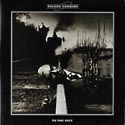
Two months later Golden Earring on March 30, 1976 left Holland again for another USA tour which lasted the month April and May 1976. This tour was broken off earlier than planned because of financial reasons. The album To The Hilt didn't have the wanted sales figures and ticket sales for concerts were not as good as expected so the band returned home and got ready to record another album. During this tour the band supported Foghat for at least two May 1976 shows.
Golden Earring stood only once in the Swedish Album charts. The Swedish hit charts were founded in 1972 and never stood a Golden Earring single in the Swedish lists. However one album made it into the Swedish hitlists. To The Hilt entered the Album Top 50 on March 15, 1976 and was in the list for two weeks with highest position 46.
The single Sleepwalking was followed by the release of another one called ‘To The Hilt’ in May 1976, but it only entered the tipparade on May 15, 1976 and didn't make it into the hitchart.
. The song To The Hilt is available on the album with the same name. It's b-side is the track Violins (Edit version of 4.59 minutes long). The album version of this song is 10.29 minutes in length. At that time the band was working in two studio's at the same time to finish the record with the same title. It was recorded with the Island Mobile and mixed and overdubbed at Island studio's Basing Street. (London, England?). George didn't dare to mix at that time and so Freddy Haayen was asked to do the job. He took over but the band wasn't to pleased with the final result. (George mentioned in a 1981 interview he thought the album was less than it could have been.)
When Robert Jan Stips was performing with Golden Earring, it often happened (in between the long tours) he could work on his own material. At a certain moment he went to the Soundpush studio with Rinus and Cesar to record the base-tracks for what later was called the "Nevergreens" lp (under the name Stars & Stips). In a next period he went with Aad Link to the Artisound studio, where he recorded all dubs and vocals. Also the contribution of Bertus Borgers, whom he met on tour with the Earring and got to know better. The record was mixed at the Soundpush studio with Jan Schuurman and later on released at the time Robert Jan was able to promote the record. Only once a few songs were played live with alle contributing members at the Nick Vollebregt's café in Laren because of the release of the record. Later on Robert Jan returned the favor to Bertus Borgers and contributed to his solo album. Some time later they started a new band called Sweet d'Buster after he returned from the 1976 Spring USA tour and left Golden Earring. Musical differences lead eventually to Stips’ departure. The artistic horizon had widened, but the Earring sound had lost the commercial potential. Robert Jan Stips mentioned in an 1999 interview: "The ‘Firm’ Golden Earring suffered through that. We stopped before real trouble started. I joined the Earring in the middle of a boys dream. I toured with them in the USA, just after the success of Radar Love. The band was in a party mood. Everything was possible. We were driven in limousines, played to sold out stadiums, toured with Santana, flew every two days to a different city. And the drugs, yes, that too they taught me. Most of the time it got out of hand. I’m glad I’ve done it all, got it out of my system.."
While on tour with Golden Earring in the USA in 1974, Robert Jan met Bertus Borgers (again) where they not only became friends but also they came to the agreement that after Golden Earring they would at least pay contribution to each others solo albums. Bertus did so on Robert Jan’s Nevergreens (vocals and lots of saxes) together with Cesar Zuiderwijk and Rinus Gerritsen. So after some time Bertus was already quite far with recording his own solo album called Sweet d’Buster, when Robert Jan was back in Holland and invited to come and dub some keyboard and synthesizer in the studio that was reckoned to be one of Holland top studio’s at the time, the Soundpush Studio in Blaricum. The production was in hands of Jan Schuurman (Robert Jan knew Jan already from his engineer work for Supersister albums) who had become the most wanted engineer in the Netherlands those days. The musicians Bertus had been rehearsing and recording with were the famous rhythm ‘tandem’ Herman Deinum on bass and Hans Lafaille on drums, both quite well known from their earlier work with Cuby and the Blizzards, newcomer guitarist Paul Smeenk, who also added vocals and contribution as co-writer, and last but not least Bertus’ soul mate and co-writer sofar Broer Boogaert. When the recordings were finished and Robert Jan also had added his parts, everyone became really enthusiastic about the results. Everyone (except for Broer B., who was not in for touring etc.) thought this album would be a perfect base to join together as a band. They also insisted that Robert Jan should take part in it, since he was right in the middle of leaving Golden Earring, anyway Robert Jan Stips wanted some more time to consider but finally accepted!
After the release of To The Hilt the album soon went gold for the sale exceeding 25.000 copies on June 09, 1976.
Soon after Robert Jan Stips left the band a new fifth bandmember was added. This time it was guitarist Eelco Gelling (Former Cuby and the Blizzards) He was asked by George and years later Eelco admitted he left Cuby without telling them, but just joined Golden Earring. Of course this was a shock for his former bandmembers but Gelling said he left that way because if he should have asked them for permission he wouldn't have done it. Gelling added more guitar to the band sound and started to play the solo guitar. Robert Jan Stips took part in a new band called Sweet d'Buster in which he performed with singer\saxophonist Bertus Borgers as well. In an 2006 interview with Robert Jan Stips could be read Stips made a fine impression while performing with Golden Earring. This band did a USA tour with Santana in the Seventies and when Sweet d'Buster was the support act for Santana during a concert on August 27, 1977 Carlos Santana and keyboard player Tom Coster recognised him, but the contact was limited to a smile and some waving to each other...
Golden Earring performed in Cologne, Germany on July 10, 1976 at the Hot Rock Night concert at The Open Air Tour with Caravan, Curved Air, Billy Cobham and John McLaughlin. Also several Dutch concert were performed in July 1976.
The album 'Contraband' was originally released in 1976. It's the first album that features the former Cuby and the Blizzards blues guitarist Eelco Gelling which makes it a very guitar orientated album. The tour that follows leads them to London where their first live album (MOVLP048) was recorded.
The album ‘Contraband’ was recorded with Eelco Gelling. It's the first album that features the former Cuby and the Blizzards blues guitarist which makes it a very guitar orientated album and much brighter record. At that time John Kriek, the sound-engineer during Golden Earring concerts, became their permanent studio technician also. That was how they started recording the album ‘Contraband’, in the Artisound Studio in Duivendrecht. Although this was a studio for advertising work, they recorded demos for the familiar low-budget reasons. But the demo recordings sounded so good, that the band decided to use them as tracks for the new album. The mixing was done at the Relight Studio in Hilvarenbeek, Holland, with Robin Freeman, a British technician. The Golden Earring sound was now really that of a real guitar band. This can be heard clearly on the single ‘Bombay’ in the intro where the guitars of Gelling and George sound great together. The hit ‘Bombay’ was released on November 22, 1976 and climbed to the 7th position. The new album called Contraband was released on November 26, 1976. The Contraband album was also released in March 1977 in the United States but with a different title ‘Mad Love’. The track listing was changed and the album has got the track ‘I Need Love’ on it, which isn't on the European release... The stage behind the band had a new look again. The theatre the band is situated in on the album cover was used as a background during concerts. This stage theatre was 6,5 meter wide, 3 meter high and painted at the Golden Earring workshop in Zoetermeer, Holland. From (at least) one out of three December 1976 shows in the Congresgebouw, The Hague a bootleg tape survived over the years and gives an good idea about the way Golden Earring sounded like with Eelco Gelling...
The new Contraband album was reviewed as stated here: After pursuing a strict art rock style on To The Hilt, Golden Earring altered its style once more on the band's next album. Golden Earring replaced keyboardist Robert Jan Stips with guitarist Eelco Gelling and put aside its art rock pretensions for a hard rock sound dominated by the group's new twin-guitar attack. The result was Contraband, the band's strongest album since Moontan. It starts powerfully with "Bombay," an exuberant blast whose elaborate arrangement works in plenty of atmospheric country-styled shadings into an otherwise hard rock track. Other highlights include "Mad Love's Comin'," a dazzlingly atmospheric rumination on romance that transforms from a tense acoustic blues into a spacy mid-tempo rocker worthy of Pink Floyd, and "Fighting Windmills," a stately tribute to being an individual (a common theme of Golden Earring songs) that works a snaky, Indian-sounding guitar riff augmented by swooning strings into the song's midsection. "Con Man" is another worthwhile track, a tribute to the raffish character of the title that highlights the electrifying guitar interplay between Gelling and George Kooymans. Despite this high percentage of strong tracks, not everything on the album is this strong: For instance, "Sueleen" and "Faded Jeans" are solid tracks but lack the sense of dynamics and powerful riffs that fuel numbers like "Bombay." However, even these lesser tunes work thanks to lean arrangements and a consistently energetic performance from the band. In the end, Contraband is a worthwhile addition to any Golden Earring collection, and well worth a spin for fans of '70s hard rock in general.
The Contraband tour that followed the album release lead them to London in March 1977 also where their first live album "Live" (2-lp) was recorded at a sold out London Rainbow theatre.
The band was broadcasted on December 07, 1976 at Avro's Toppop with their new single Bombay. On December 11, 1976 the Bombay single entered the Dutch national Top 40 hitlist, highest position 07, 09 weeks in charts (Catalogue info: Polydor 2121 312)
George Kooymans did the production for the Cake vinyl single ‘No Money, No Love’. The band Cake was also support act for several Golden Earring shows in September 1976. Bilbo Baggins released the single Back Home/What's Goin' On (Polydor label 2058-667) in 1976 the Netherlands, UK and Germany.
Barry Hay did produce Gruppo Sportivo's debute single called Out There In The Jungle which was released on the Polydor label and got some airplay on national radio. The single ended up in the Dutch Tipparade. Gruppo Sportivo was also asked to do several support acts for Golden Earring which boosted their career as well.
When still playing in Sweet d’Buster, Robert Jan Stips took over the production of Gruppo Sportivo records from Barry Hay. Their first album ‘Ten Mistakes’ sold over 50.000 copies (good for a gold record), the second one ‘Back To ’78’ passed the 100.000 and became platinum awarded in The Netherlands.
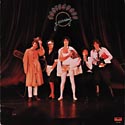
In 1976 some Golden Earring song covers were known now. The exact year of issue is to be researched. Here is an overview of these covers mentioned in the June 1976 Golden Earring Fanclub magazine (Page 4):
197? Dong Dong Diki Digi Dong\M' Lady Molly O Dean by Hajo (Germany Fontana TF 469-212)
197? Dong Dong Diki Digi Dong|Bubblegum March by Super Circus (USA Super K label SK9)
197? Dong Dong Diki Digi Dong\Nena te quero tanto by Carlos Bisso (Argentina RCA 31 Z 1570)
197? Dong Dong Diki Digi Dong\Skaffa dig & Plats I solen by Tre Hits & Miss (Sweden Mercury 131-405MCF)
1973 Buddy Joe\Ne me dis pas good-bye by J.P. Besson (France Philips 6009-343)
197? Back Home\What's Going'on by Bilbo Baggins (USA Polydor 2058-667)
1977 - On January 29, 1977 the Bombay single was released in England as well with b-side Faded Jeans (Catalogue info Polydor 2121 312)
On February 26, 1977 the Australian JUKE music newspaper magazine #93 (Australia) contained a Golden Earring record review.
On February 26, 1977 Golden Earring made recordings in Winterswijk for their upcoming double album ‘Live’ for which as almost everybody know, most of the songs came from the London Rainbow gig a month later, but does somebody know what was played there, since Eight Miles High wasn't performed in London. Also the To The Hilt and Vanilla Queen tracks are from a different source and probably recorded at Winterswijk, Holland.
In March 1977 Golden Earring flew to the UK in two small airplanes with their girlfriends and performed a sold outbenefit show at the legendary Rainbow Theatre, at Finsbury Park in London on Friday March 25, 1977 for Londons Capitol radio station. The recordings were broadcasted on Capitol radio on April 08, 1977 and the proceeds for the charity concert went to the "Help a London child" foundation. The album ‘Live’ was released on double-lp with recordings from the Rainbow concert and recordings from two concerts at Winterswijk, Holland. Excellent dual-play between Kooymans and Gelling can be heard on this album. The band is live at it's best! The double album "Golden Earring Live" sold well too in the United States and paved the way for another U.S.A. tour. During that visit, Golden Earring supported the likes of Led Zeppelin, Kiss and Aerosmith.
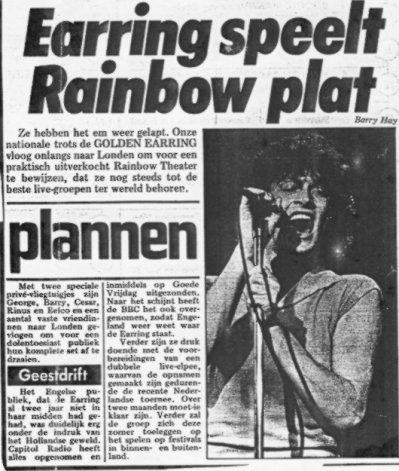
In Spring 1977 the Contraband album is released in the USA under the name "Mad Love" in the USA and Canada. For these markets the song Faded Jeans was omitted from the album and replaced with the song "I Need Love" which is not on the European Contraband lp version. On May 28, 1977 the "Mad Love" album entered the  album list in the USA.
album list in the USA.
Golden Earring performed at the Pinkpop festival (Geleen, Holland) for the second time in their career on May 30, 1977. They performed the song ‘I Need Love’ live which hasn't been played live very much afterwards (untill the acoustic shows). The day ended up at the policestation for Barry Hay. After the Golden Earring show he took an lsd-trip backstage and when driving home he only rode a few hundred meters untill he hit a tree. Still being under the influence he was arrested but didn't "recognise" the policeman as being in function. He spent the night in jail and PinkPop organiser Jan Smeets had to use all his influence next day to get him out. Later on Barry got sentenced to jail. After this bad trip he never took LSD again he mentioned in a 2005 newspaper interview (Telegraaf, May 16).
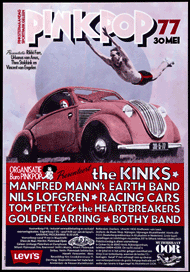
On August 28, 1977 Golden Earring performed at the IJsselhallen, Zwolle in front of 4000 fans and this concert was broadcasted on tv as well on September 27 1977 by the AVRO on Dutch TV Nederland 2. (TopPop TV special)
In August 1977 the first Golden Earring live album is released. It's called Live and is a double album. From this album the Just Like Vince Taylor\Radar Love single is released. (1977 live version)
The 1977 "Live" double-album opus represents Golden Earring's entry into the series of live albums that were so popular in the late '70s. At this point in their career, the band's live sound had a newfound sense of power, thanks to the addition of second guitarist Eelco Gelling. Indeed, classics like "Radar Love" and "She Flies On Strange Wings" benefit from a newfound complexity and energy that stems from the energetic guitar interplay between Gelling and George Kooymans. Golden Earring's new double-guitar sound also allowed the group to overhaul some of its material in new and interesting ways. For instance, "To The Hilt" is transformed from the short country-flavored tune that appeared on its similarly titled studio album into a stomping, twin-guitar epic in the live arena. The downside of Live is that the group sometimes gets carried away with its newly refurbished sound and allowed some of the tunes to degenerate into pointless noodling: "Mad Love's Coming" drives its hypnotic riff into the ground by overextending itself a few minutes too far and the group's fire-breathing remake of the Byrds' classic "Eight Miles High" undercuts its considerable energy by dragging the song out to ten self-indulgent minutes. These criticisms aside, Live remains a solid portrait of the group's live act at this juncture of its career and further benefits from a sharp, full-blooded sound (the engineer was future U2 producer Steve Lillywhite!). All in all, Live is an album for the casual fan and will keep the group's following entertained as the band performed at their best.

On September 03 1977 the band attended the First Rider Open Air festival at Scheessel, Germany. Many groups on the were announced on the program but never played due to failing organisation. Riots started right after Golden Earring closed the concert due to missing bands. When the audience realised this riots broke out and fire was set to the festival place and the stage burnt down completely. (Source: Musiker magazine (Germany) October 1977)

October 1977 marked a single release with a double a-side: Radar Love (live)\Just Like Vince Taylor (live). It was released in October 1977 and entered on October 01 1977 the Dutch national Top 40 hitlist. The single stayed 04 weeks in the chart and it's highest chart position was 30 only. The single was promoted in England by performing for the popular tv program "Top Of The Pops". In England this track was also released and the first 10.000 copies of the single were released as a 12-inch record. To my knowledge this is the first Golden earring 12 inch maxi single. On September 17, 1977 the UK Melody Maker magazine had an add for the double a-sided Radar Love Live single. On October 08 1977 the Radar Love track with b-side Just Like Vince Taylor (The Live 2-lp version) entered the UK hitparade and highest position was #44. Some months earlier the band performed at the Reading Rock'77 Festival (August 1977)
On November 11, 1977 George Kooymans, Rinus Gerritsen, Eelco Gelling and Cesar Zuiderwijk left Dutch national airport Schiphol for the United States to do another USA tour again. Barry Hay left one day earlier with Freddy Haayen for some business in London. Golden Earring did tour as a support act for Aerosmith and Ted Nugent in the USA from the end of November 1977 on. Golden Earring did a few shows as a headliner (with support acts Rex and Legs Diamond). One of these shows was on November 27, 1977 at Houston, Texas at The Houston Music Hall. The band Rex was Ted Nugent's opening act for many years. From December 1977 on the band started to support Ted Nugent for several concerts. The tour continued in early 1978. Some concerts were done as a support act for Aerosmith. This wasn't a surprise as the USA tour management in the USA was done by Leiber & Krebs, who also did the management for Aerosmith. In the middle of this tour Rinus Dan Electro Longhorn bassguitar was stolen from his New York hotel room. Of course this meant a great loss to the musician! Rinus seemed to have been standing motion-less on stage for several concerts, much contrary to the energetic stage performer he alwas has been. It was also during this tour George Kooymans saw Aerosmith guitarist Joe Perry play a BC Rich guitar. The guitar is nick named the "Rich Bitch" as it can be made a 10 string guitar as well. George Kooymans found the guitar to be intriguing as they were at that time quite classical shaped. This one had a differing design and was quite light weighted and sounded very good. Once back George forgot about the guitar but years later he found himself a copy at Gerritsen Music Store in The Hague and bought it instantly. The guitar remained in use for many, many years (From the early Eighties untill 2008). Only once George was not satisfied with the monitor sound on stage and threw the guitar in anger to the monitor engineer in a moment of "temporary madness". He instantly regretted this move as the guitar neck broke and he to be repaired. This was done at the Vox Humana guitar (repair) shop in Vlaardingen where Rinus Gerritsen also is a regular customer.
1978 - After the mentioned American tour the band visited on March 19, 1978 their own first Golden Earring fanclub day. This was held at the Palladium, Scheveningen Holland. Video's were shown as well as the Eight miles high movie. All members including Eelco Gelling were attending and gave lots of autographs to all fans. Also the Golden Earring Top 100 was played by Drive in disco show Quality Sound.
The base recordings of ‘Grab It For A Second’ were done in the Dutch DMC studio's (Baarn). At the Record Plant recording studio (New York City) in the United States they finished the recording. The album was mixed at The Record Plant also. Mastering was done by Greg Calbi at Sterling Sound, New York City.

The production was done by Jimmy Iovine. (He later on produced U2, the Simple minds and the Pretenders also to name a few). This album is full of energetic stadium rock. It was Golden Earrings most expensive record recording ever due to Iovines way of working. (The record was recorded for about 290.000 guilders!) Eelco Gelling is to be heard on this record for the last time. Release date for Grab It For A Second was September 06, 1978. Grab It For A Second" was released on MCA records label with label number MCA-2183. Despite the failure of the album, and the demise of the MCA deal, Golden Earring toured the United States again in Fall of 1978. Most shows were performed as the support act for Aerosmith, but also several concerts as a headliner were given. At least four shows were done with the Canadian band Rush during their Hemispheres tour (December 02, 1978 Cobo Hall, Detroit, Michigan\December 03, 1978 Sports Arena, Toledo\December 07, 1978 Milwaukee Arena, Milwaukee, Wisconsin and December 10, 1978 Veterans Memorial Auditorium, Des Moines, Iowa) as stated on several Rush fan sites.
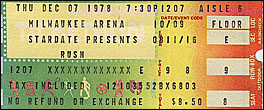
During this new American tour there were personal problems between Eelco Gelling and the other band members especially George. In the middle of the tour the band decided to go on as a quartet again. George did the lead vocals with Barry more and more and so the Earring became an unique two-headed vocal frontline and found their "classical" line up as a quartet again. Eelco Gelling finished the tour with the band, but didn't perform on stage anymore. His guitar parts were played by Ad van Son, who played unseen behind the amplifier wall. The band returned on December 21, 1978 at Schiphol Airport. The tour was ended sooner than planned. (As the band played as Ted Nugents support act, there was too much time between his concerts to play shows. So it would have been very expensive to stay in the USA).

The band looked back with mixed feelings on what looked as a jump forwards. ‘Movin' Down Life’ became a small hit (October 1978 released, position 27) but couldn't hide Golden Earring was on lower grounds, both artistically as financially. (Another song on the album, "Cell 29", was written about an event Barry Hay would not care to relive. Following the Pinkpop concert in 1977, Hay drove his car directly into a police car. Both vehicles were totally wrecked, although Hay escaped with minor injuries. He was sentenced to jail for a couple of weeks. Some of his experiences in jail can be heard in the song Cell 29 which was written in his prison cell in the Dutch city of Hoorn. Another USA tour was done. But soon after their return in Holland they found out that all the luxurious hotels, expensive limousines and fine parties had to be paid by themselves. Managers got a huge percentage of the profits and so Golden Earring didn't earn anything at all in the end. They had to pay off their debts in the next coming years and even the Dutch tax came by to collect their share. ("Troubles, hassles, I know you to well")
Another explanation for the Cell 29 track is this song is about Lesley M, former Factory Bar owner where Golden Earring and its crew came many times. Lesley seemed to have been a legendary safe cracker and was caught after an bank robbery. Golden Earring seemed to have performed the song live for him at an Rotterdam prison according to a well informed website..... This story makes more sense than the first one as the lyrics "He's planning a robbery, Lack of common sense, Bad vibes and a story That stands for accidents" point out to a bank robbery.....
When Barry returned from one of the USA tours he found his house had gone up in flames and then moved to Zoetermeer. But around 1978 he moved to The Hague again and bought a former funeral center in the Willem Barentsstraat. (He would stay in this house untill 2001 and moved to Amsterdam then.)
Around 1978 Cesar was asked to join the Who to replace their drummer Keith Moon who had experimented so much with alcohol and drugs he almost died. Cesar had the consent of all other three GE-members but decided to stay with the band. But it showed how much talented he was that a major foreign band asked him to join their band... But on September 07, 1978 drummer Keith Moon suddenly died at the age of 32 and was replaced by ex-Small Faces drummer Kenny Jones on December 22, 1978.
In North America noted biker band The Godz lent 'Candy's Going Bad' valuable exposure by including a rendition on their The Godz debute album which was released in several countries. (LP on RCA label XL 13051). Later on this track was put on the Godz 'Power Rock from USA' cd. A live version excists on the 1995 Greatest hits cd (High Chief records)
In 1978 a Candy's Going Bad cover was released by:
1978 USA: The Godz - The Godz (LP RCA XL 13051)
Golden Earring is present on the soundtrack for the French Movie Les Petits Calins. For this movie the songs Ce Soir and Fighting Windmills were used. (French LP on Polydor label, label number 2310.598)
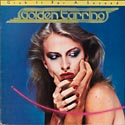
1979 - Golden Earring regrouped in its native Holland to record a new album. This time, lead guitarist George Kooymans took over the production reins and all the group's members collaborated to write the album. With a modest budget ‘No Promises, No Debts’ was recorded. No Promises... No Debts remains a stylish, consistent album of pop-flavored hard rock that will please Golden Earring fans as well as the casual listener. But it is a rather fragmentary album, which has another huge hit called ‘Weekend Love’ (Release June 1979 highest chart position: 3) on the record. Although this song is rather poppy, other tracks like Tigerbay, D-light and Save Your Skin are good old rockers. Need her and Sellin' out are much more quiet but still great songs. Weekend Love was written in a few minutes while George was kind of drunk and recorded it right away on an eight-track recorder. With the demo tape they went into the studio but couldn't get it they way they wanted it to be. Finally the demotape was used for the album. The song seemed to be a perfect single at the time of the recordings so it was released as the first single from the album.
No Promises, No Debts was recorded at Phonogram Wisseloord Studio's, Hilversum Holland and mixed by John Kriek and George Kooymans at Arnold Muhren Studio Volendam. The Dutch executives at Polydor were able to convince their American counterparts to sign the group stateside for two albums, so Grab It For A Second was released in the USA and Canada also, but with a different album cover. The album cover was shot by photographer Kees Tabak. In fact the "jumping photo" of the band which can be seen on the (different) USA and Canadian cover of the album was the very first photo Kees made of the band. Grab It For A Second" was released on MCA records label MCA-2183 in 1978. The No Promises, No Debts" album was released on Polydor records and a white label promo with label number PD1-6233 also excists.
During the concert at Zevenhuizen (Groningen) on August 18, 1979 a serious accident happened. George got injured in his neck (right side) due to the preliminary explosion of a magnesium bomb which was attached to his guitar neck. George was taken to the Groningen Academic hospital by ambulance and treated while the concert was cancelled. The injury was severe and almost cut George his neck artery which would have been fatal. A scar at the right side of George's neck remained and reminds of this incident.
The band performed live at the Casa Nova youth fair at Ahoy Rotterdam on August 31, 1979. Their support act would have been New Adventures but due to family circumstances of this band they were replaced by The Scene. The follow up for Weekend Love became ‘I Do Rock 'n Roll’ which was released in December 1979 with highest chart position 29. I Do Rock 'n Roll is another "single only" track but can be found on several vinyl and cd-samplers. The b-side was Sellin' Out from the No Promises...No Debts album. But I Do Rock'n Roll was another deception, the group admitted later on. The band focussed on shorter compositions and also shortened the duration of their long length songs during concerts, despite the band didn't found connection with the by punk, new wave and disco sounds dominated spirit of time.
In 1979 Rinus Gerritsen released his first (and only) soloalbum so far called Gerritsen en Van Dijk. As the title revealed he made this album with ex-Alquin singer Michel van Dijk. On the album you can also hear Eelco Gelling on guitar and Shell Schellekens on drums (He later on produced several Golden Earring albums in the Eighties). There was a single release from this album called Rock and roll beast. The b-side was a single only bonustrack and is called Suzy's song (Written by Rinus and Michel). The single is hard to find and a collectors item. This album was never pressed on an offical cd release untill now. Fans can order a cd-copy at the www.fonos.nl site. The album was renamed to Garrison and Van Dyke for the American market and released through ATCO Records, a division of Atlantic Recording Corporation (Atlantic Records label ATL 38 119).
To promote the Garrison and Van Dijke release, special promotional posters were printed by ATCO, to be hung in record-shops. It's questionable if these posters were used after all, because this record totally did fail to hit any charts in the USA. Normally, these posters were used, and after that usually they were thrown away. So not many are left, and finding one in unused, like new condition, is rare. This original record shop promotional poster for the 1979 Garrison and Van Dyke-album measures about 60 by 60 centimeters and is probably one of the rarest promotional posters related to Golden Earring.
The New Adventures toured as a supportact for Golden Earring, signed a record deal with Polydor and went into the studio in December 1979 with George Kooymans for the recording of their first album.
Golden Earring did perform at the Merwehal December 28, 1979 at Dordrecht which was broadcasted live for TROS Radio at the TROS Musifest. Tracks played are Don't Stop The Show, Movin' Down Life, Leather, She Flies On Strange Wings, Heartbeat, Weekend Love, Radar Love and I Do Rock 'n' Roll.
Barry Hay was heard on the lp Buddy Odor Stop - Buddy Odor Is a Gas! He co-wrote the song If I Were You together with Hans Vandenburg and sang along on this song. The album was released on cd in 2000 (Gruppo Sportivo: Ten Mistakes\The Buddy Odor Stop). Buddy Odor is wordplay for Body Odor (Body smell). Both Barry Hay and Hans Vandenburg like the use of wordplay in their song writing.
The Buddy Odor Stop is actually an offshoot of the Dutch group Gruppo Sportivo as they share many of the same performers. Gruppo Sportivo itself came together out of two Hague-based bands. Guitarist Hans Vandenburg and vocalists Meike Touw and Josee Van Iersel were in one outfit while keyboardist Peter Calicher, drummer Max Mollinger, bassist Eric Wehrmeyer in another. The six started collaborating in 1976, eventually attracting the attention of Golden Earring's Barry Hay and Robert Jan Stips who helped them score a contract with Philips. Barry Hay also produced their debut single 'Out There In the Jungle' b/w 'I Can't Stop Loving You' (Catalog number Philips 2050 434).
1979's "Buddy Odor Is a Gas" was actually marketed as a Hans Vandenburg solo effort, but for all intents and purposes served as Gruppo Sportivo's third set. Co-produced by former Golden Earring member Robert Jan Stips and Vandenburg the album offered up a weird mixture of new wave, pop and comedy moves (much of it performed with a distinctive Dutch accent). Material like 'Buddy Odor Is a Gas!' and '(Gimme That) Lipstick' sounded a little like Flash In the Pan with an accent. In contrast 'Teardrops and Two Broken Hearts' sported a retro-1950s feel. The flip side sported a totally different vibe, largely forsaking their rock moves for a pseudo-jazzy feel showcasing Touw and van Iersel on vocals (though with the same weird lyrics). Ultimately the set does start to reveal some of its charm, though part of it may stem from these guys were simply a bunch of dweebs. Elsewhere long time mentor Barry Hay co-wrote 'If I Were You'. (Catalogue info: Ariola Benelux 200 931)
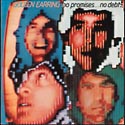
To be continued!
LAST UPDATE: December 22, 2019
Please be aware of the fact that this page is still under construction and is constantly being updated and extended. So far some milestones in Golden Earrings glorious career have been highlighted but of course a lot more has happened during the past 40 years! So please keep checking back here and view the latest news as well as the latest additions about Golden Earrings history or should I say "Hitstory!" For this story many sources and clippings from papers and magazines are used frequently. They are so many I can't mention them all. Because of those many sources I can't garantee all facts are true or at the right date. Where possible they have been crosschecked and verified. If you believe facts are not true please email the webmaster! Also some of the info was taken out of the booklet with the 4cd "The Devil Made Us Do It" for which I provided a lot of information and therefor being mentioned in the credit section. (Which I'm very proud of of course! Actually I supplied a Golden Earring Record Research Report print 4 to Rinus Gerritsen on his request, which was used for the booklet info!)
This is a Fan site and has no direct connection with the band Golden Earring.
It's intention is to act like a library that covers and references the history of the band for fan enjoyment.
© 2003-2022 Casper Roos\Golden Earring Research, Zoetermeer, Holland. All rights reserved.
